The Future PT’s Guide to Becoming a Physical Therapist
Whether looking at potential career paths or a career change, becoming a physical therapist can be deeply rewarding.

Get the latest news and tips directly in your inbox by subscribing to our monthly newsletter
Becoming a physical therapist requires a passion for—and quite a bit of schooling in—subjects like anatomy, biology, kinesiology, biomechanics, neuroscience, and exercise physiology (as well as a love of working with people). Though the cost of PT education continues to rise, the rewards of helping people improve function, mobility, and overall well-being are vast. If you’ve got questions about this career path, then we’ve got answers. Read this future physical therapist guide to learn everything you need to know about becoming a physical therapist.

What do physical therapists do?
A physical therapist is an expert in treating patients with neuromusculoskeletal conditions—anything from low back pain and joint injuries to post-stroke symptoms and cerebral palsy. As a physical therapist, you could work with patients of any age to help them:
- Recover from an injury or surgery;
- Improve strength, flexibility, and balance;
- Learn and grow through developmental milestones; and/or
- Maintain mobility and function as they age.
To accomplish this for a patient, you would:
- Establish good rapport.
- Review the patient’s medical history.
- Perform an initial evaluation to assess the issue or condition and determine if PT would be appropriate.
- If PT is appropriate, create a plan of care detailing the evidence-based treatment type (e.g., exercises, stretches, hands-on therapy, equipment use, and/or a home exercise program), frequency, and duration necessary to help the patient achieve his or her therapeutic goals.
- Follow the treatment protocol detailed in your plan of care (POC) while adhering to all insurance and state rules and regulations.
- Teach the patient —and family members, if appropriate—how to safely perform daily activities and improve their progress with an at-home exercise program.
- Monitor the patient’s progress using outcome measurement tools, adjusting the POC as necessary until the patient reaches his or her goal.
Where do physical therapists work?
Physical therapists may see patients in private clinics, patient homes, hospitals, nursing facilities, schools, or sports arenas. They can work one-on-one with patients or serve as members of a larger care team. Some physical therapists oversee physical therapist assistants or physical therapist technicians (techs) . Physical therapists may work for one clinic in one location—or they may travel to different clinics around the country (travel PTs) or different clinics in a particular region (registry PTs). To learn more about travel PT, check out our travel PT checklist —or you could learn more about registry PT and per diem opportunities .
Physical therapists may also work in non-clinical roles (e.g., as executives in healthcare companies , researchers, directors, teachers, writers, or consultants).
Want to own a physical therapy private practice one day?
Download the PT’s guide to starting a private practice , and you’ll learn everything you need to know about starting a successful clinic—including picking a location with the right amount of curb appeal and crossing your legal t’s and dotting your credentialing i’s.
How do physical therapists find patients?
Traditionally, physical therapists have largely relied on physician referrals to keep their treatment schedules full. In other words, physicians determine which patients are good candidates for physical therapy—and send those patients to a specific physical therapist.
Today, however, some form of direct access exists in all 50 states, making it possible for most therapists to—at the very least—perform an initial evaluation without needing a physician referral first. Thus, many providers are expanding their marketing initiatives to reach patients directly . Given that patients are now responsible for a greater portion of their healthcare costs, many are conducting their own research—specifically, online research—about providers and treatment options instead of relying on a referral from their primary care provider (PCP). That’s why it’s important for physical therapists to have an optimized online presence that includes a professional website , positive online reviews , and an active social media presence . That said, most physical therapists still maintain good relationships with physicians and surgeons and obtain many of their patients through the traditional referral process.
How much money do physical therapists make?
According to the Bureau of Labor Statistics (BLS) , the median pay for physical therapists in May of 2022 was $97,720 per year and $46.98 per hour—with the lowest 10% earning less than $67,900 and the highest earning more than $128,830.
The industries that hire the most physical therapists are:
*According to the Department of Labor, this category includes offices of chiropractors; optometrists; mental health practitioners (except physicians); physical, occupational, and speech therapists as well as audiologists; and all other health practitioners.
The top-paying industries for physical therapists are:
Location Matters
Keep in mind that the above-noted numbers are national averages. These stats will differ depending on where you live. The states with the highest number of employed physical therapists are:
The top-paying states for physical therapists are:
Download your free copy of the PT Salary Guide.
To find out what physical therapists make in your neck of the woods—including a complete state-by-state and metropolitan area breakdown— download our free salary guide here.
Experience Matters
According to Payscale.com , experienced physical therapists receive a salary 13% higher than the national average, whereas entry-level PTs receive a salary 9% lower. The average entry-level salary for a physical therapist is $69,073.
What kind of job outlook do physical therapists have?
The demand for physical therapy is growing—and will continue to grow —as more people recognize the need for safe, cost-effective, conservative, and long-term treatment options to address neuromusculoskeletal and chronic conditions such as diabetes and obesity. With the opioid crisis falling under the national spotlight, payers and legislators are feeling the pressure to find and deliver alternative treatment options—like physical therapy—to their patients. If that’s not enough, according to BLS , many baby boomers are staying active later in life and thus, require the regular attention of a physical therapist. To that end, physical therapist employment is expected to grow 17% from 2021 to 2031, which is “much faster than the average for all occupations.”
So, what does that mean for you? If you pursue a career in physical therapy, you’ll likely land a job right out of school given that “job opportunities are expected to be good for licensed physical therapists in all settings,” and are “particularly good in acute-care hospitals, skilled-nursing facilities, and orthopedic settings, where the elderly are most often treated.” The outlook is even better if you want to work in a rural area, because most practicing physical therapists already work in “highly populated urban and suburban areas.”
What kind of software do physical therapists use?
Whether working as an individual provider or within a large practice group with other healthcare professionals, an electronic medical record (EMR) to record and store patient health information is the start of simplifying clinical workflows. Ideally, physical therapists will choose an always-up-to-date, cloud-based EMR and practice management platform that’s designed for physical therapists and provides not only defensible documentation, compliance alerts, and a streamlined workflow but also:
- intuitive scheduling functionality and automated appointment reminders that reduce patient cancellations and no-shows by as much as 30%, and patient self-scheduling software that patients are actively seeking to use;
- fully integrated clinical outcomes tracking with a library of standardized, risk-adjusted tests;
- enhanced multimedia home exercise programs ;
- robust practice intelligence analytics ;
- comprehensive billing solutions that increase payments per visit by up to 10%; and
advanced patient engagement and marketing tools.
What does it take to become a physical therapist, personality traits.
A provider’s personality greatly affects a patient’s willingness to complete his or her course of care—and thus, his or her therapeutic outcome. It’s safe to say that a provider’s personality matters. Do you have the personality necessary to be a successful PT? Here are some important traits for a future PT to possess:
- Compassionate
- People-Oriented
- Conversational
- A Critical Thinker
- A Puzzle-Lover
- Accountable
- A Good Decision-Maker
- Cooperative
- Passionate About Functional Movement and Well-being
Students who are interested in becoming physical therapists must first earn a bachelor’s degree from an accredited university. Then, they’ll go on to earn a doctorate of physical therapy (DPT) from the graduate school of their choice. A growing number of schools accept students directly out of high school for three years of undergraduate coursework plus three years of graduate-level education.
While you don’t have to select a pre-physical therapy or pre-med major, most graduate schools require students to have a significant amount of applicable prerequisite courses in subjects such as chemistry, physics, biology, anatomy, psychology, statistics, mathematics, and English writing. (The Physical Therapist Centralized Application Service has a detailed chart of what each DPT program requires.) Thus, selecting a major with a heavy emphasis on science would be a wise choice (though certainly not mandatory). If you complete, say, a fine arts degree, you may still be able to attend PT school; you might just have to take additional courses to meet the prerequisite course requirements before matriculation. (To learn what your school-of-choice requires, check out its admissions page; for the top-ranked PT programs in the country, scroll to the next section of this page and click the link in the prereqs section of each school.)
Prerequisites
Other prerequisites often include:
- A solid GPA ( the University of Pittsburgh , for example, only accepts students with a GPA of 3.0 or higher);
- Good Graduate Record Examinations (GRE) test scores taken within the last five years; and
- Adequate exposure to the profession through volunteer or paid experience in a clinic or hospital.
So, if you plan to pursue a career as a physical therapist, you’ll want to keep your grades up in college and practice for the GRE—and you may want to begin applying for physical therapy internships early in your undergraduate career to ensure you can demonstrate a wealth of experience once it comes time to apply to grad school.
Traditional Residential Programs vs. Alternative Hybrid Models
Most physical therapy programs are full-time, three-year programs—which means you must attend classes at the university campus. There are, however, some alternative DPT programs with a hybrid learning model that enables students flexibility in how they finish their DPT program. These models typically take the shape of:
- a mostly online format ,
- a part-time attendance format, or
- an accelerated program .
With the growing need for PTs in practice and the industry’s recognition that student debt is a problem, hybrid models have become commonplace in almost every state. Choosing the right type of program for you can take some deliberation, so try Mike Reinold's podcast episode to help steer you in the right direction.
Each school has its own requirements regarding the coursework you must complete to graduate. For instance, here is a list of courses at the University of Southern California . Overall, the direction of coursework is determined by the Commission on Accreditation in Physical Therapy Education (CAPTE) who is responsible for overseeing the maintenance of current programs in physical therapy and accrediting new programs.
Once you receive your DPT, you’ll be ready to sit for your multiple-choice licensing exam: the National Physical Therapy Examination (NPTE) . According to the NPTE website, “the NPTE is only one part of the evaluation process used by licensing authorities to assess your competence. Contact your jurisdiction to find out what additional requirements there are, such as taking the jurisprudence exam .”
In other words, be sure to review the requirements for licensure in your state, so you know what to expect before it comes time to graduate as a DPT.
Credentialing
If you’re opting to go in-network with insurance companies , then you’ll need to receive credentials from those payers. As explained in our free billing guide, “Some payers— like Medicare —do not allow non-credentialed providers to treat or collect payment from patients for any covered services.” To apply for credentials, you’ll need:
- malpractice insurance,
- a physical clinic location, and
- a license to practice in your state.
If you join an in-network practice, that company may already have an established credentialing process that will help you get credentialed with the right insurance companies.
Post-Graduate Study
If you choose to further your education beyond your doctorate through clinical fellowships or residency programs, you may do so. According to the American Physical Therapy Association (APTA) , these are great ways for “licensed physical therapists to enhance their knowledge and practice.”
Per the APTA, a clinical residency program is “designed to significantly advance a physical therapist resident's preparation as a provider of patient care services in a defined area of clinical practice. It combines opportunities for ongoing clinical supervision and mentoring with a theoretical basis for advanced practice and scientific inquiry.”
On the other hand, clinical fellowships are offered to physical therapists “who demonstrate clinical expertise in an area of clinical practice related to the practice focus of the fellowship. (Fellows are frequently post-residency prepared or board-certified specialists.)”
Board Certification
If you wish to “build on a broad base of professional education and practice to develop a greater depth of knowledge and skills related to a particular area of practice,” then you may want to consider becoming a board-certified specialist through the American Board of Physical Therapy Specialties (ABPTS) in one of the following areas:
- Cardiovascular and Pulmonary
- Clinical Electrophysiology
- Orthopaedics
- Sports Physical Therapy
- Women's Health
Where should I go to school to become a physical therapist?
While the PT school you choose to attend is ultimately up to you, the APTA urges anyone considering a career as a physical therapist to choose a Doctorate of Physical Therapy program that is accredited by CAPTE —otherwise, you may not be eligible to sit for your licensure exam, and only licensed PTs may practice. With that in mind, below are the US News and World Report’s top-ranked PT schools (all of which are accredited by CAPTE). That said, rankings aren’t everything , so be sure to do your own research on all schools you’re considering, including visiting each one and talking to students about their experience.
According to the Report, “each school's score reflects its average rating on a scale from 1 (marginal) to 5 (outstanding), based on a survey of academics at peer institutions.” (Additional details below were collected from each university, the CAPTE website , Peterson’s , and the PTCAS by the APTA . We make no guarantees as to the accuracy or currentness of this information.)
University of Delaware in Newark, DE
- Contact Phone Number and Email: (302) 831-4576 | [email protected]
- Program Director: Gregory Hicks, PT, PhD | Associate Professor and Chair
- Cohort Size: ~60 students
- Tuition: $1,051/credit hour
- Acceptance Rate: 26%
- Program: In-person full-time DPT
- School Type: Public
- Prereqs: Bachelor’s degree +
University of Pittsburgh in Pittsburgh, PA
- Contact Phone Number and Email: (412) 383-6630 | [email protected]
- Program Director: James J Irrgang, PT, PhD, ATC, FAPTA | Professor and Chair
- Cohort Size: ~198 students in the graduate program
- Tuition: $41,796 per year
- Acceptance Rate: 27%
- Program: In-person full-time DPT
Washington University in St. Louis, MO
- Contact Phone Number and Email: (314) 286-1400 | [email protected]
- Program Director: Gammon Earhart, PT, PhD
- Cohort Size: ~81 students in the graduate program
- Tuition: $20,362 per academic semester | $3,328 to $4,992 per clinical education segment
- Acceptance Rate: 40%
- School Type: Private not-for-profit
Northwestern University in Chicago, IL
- Contact Phone Number and Email: (312) 908-8160 | [email protected]
- Program Director: Julius P. Dewald, PT, PhD | Chair and Program Administrator
- Cohort Size: ~95 students in the graduate program
- Tuition: $121,688 per year
- Acceptance Rate: 17%
University of Iowa in Iowa City, IA
- Contact Phone Number and Email: (319) 335-9791 | [email protected]
- Program Director: Richard K Shields, PT, PhD, FAPTA | Professor and Director
- Cohort Size: ~42 students in the graduate program
- Tuition: $7,858 for Iowa residents / $16,608 for non-residents per semester
- Acceptance Rate: unavailable
University of Southern California in Los Angeles, CA
- Contact Phone Number and Email: (323) 442-2900 | [email protected]
- Program Director: James Gordon, PT, EdD, FAPTA | Associate Dean and Chair
- Cohort Size: ~95 in the residential DPT program | ~48 in the hybrid program
- Tuition: $67,389 each for years 1 and 2; $40,715 for the third year
- Acceptance Rate: 16% in 2017 (for the in-person program)
- Program: In-person full-time DPT and full-time hybrid
- School Type: private not-for-profit
Duke University in Durham, NC
- Contact Phone Number and Email: (919) 681-4380 | [email protected]
- Program Director: Chad E. Cook, PT, PhD, MBA, FAAOMPT
- Cohort Size: ~82 students accepted each year
- Tuition: $38,000 per year
- Acceptance Rate: 84% (of early-decision applicants who are interviewed)
Emory University in Atlanta, GA
- Contact Phone Number and Email: (404) 712-5660 | [email protected]
- Program Director: Marie A. Johanson, PT, PhD, OCS | Interim Program Director and Professor
- Cohort Size: ~155 students in the graduate program
- Tuition: $11,100 per semester (as of 2016)
- Acceptance Rate: 25%
MGH Institute of Health Professions in Boston, MA
- Contact Phone Number and Email: (617) 726-8009 | [email protected]
- Program Director: Julie J. Keysor, PT, PhD
- Cohort Size: ~118 students in the graduate program
- Tuition: $27,780 for the fall semester of 2023, tuition rates fluctuate by semester
- Acceptance Rate: 19%
The Ohio State University in Columbus, OH
- Contact Phone Number and Email: (614) 292-5922 | [email protected]
- Program Director: John A. Buford, PT, PhD
- Cohort Size: 47-50 students accepted each year
- Tuition: $6,932.40 per semester for Ohio residents / $16,016.40 per semester for non-residents
- Acceptance Rate: 20%
Creighton University in Omaha, NE and Phoenix, AZ
- Contact Phone Number and Email: (402) 280-2662 | [email protected]
- Program Director: Kirk Peck, PT, PhD, CSCS, CCRT, CERP
- Cohort Size: ~61 students in the graduate program
- Tuition: $38,040 for the first year; $56,550 for the second and third years
- School Type: Private
University of North Carolina - Chapel Hill
- Contact Phone Number and Email: (919) 966-4708 | [email protected]
- Program Director: Deborah Givens, PT, DPT, PhD, FAPTA
- Cohort Size: 30-32 students in the graduate program
- Tuition: $9,201 max, per semester for NC residents; $18,347 max, per semester for non-residents
- Acceptance Rate: 33%
What other options are available to me in the PT field?
If you decide not to become a physical therapist—but you enjoy the rehab therapy field—you can also become:
- an occupational therapist;
- a speech-language pathologist;
- a therapist assistant (PTA, OTA, or SLPA); or
- a therapist technician.
Or, if you’d rather forego clinical work altogether, you can choose to work in the front or back office of a clinic, performing administrative or billing tasks. Finally, you can apply to work for a leading technology company in the physical therapy space—like WebPT. So while you're here, check out our careers page .
PT vs. PTA vs. Tech
While there is certainly overlap between physical therapists, physical therapist assistants (PTAs), and technicians (a.k.a. aides), there are some important distinctions. For example, in a clinical setting, all three roles work with patients; however, physical therapists are responsible for creating—and overseeing—patient plans of care. Thus, they are the ones who must :
- Interpret patient referrals,
- Complete all evaluations,
- Diagnose patient conditions,
- Supervise PTAs and techs,
- Cosign all PTA-completed notes, and
- Establish discharge plans.
Physical Therapist Assistants
According to the APTA , PTAs “implement selected components of patient/client interventions (treatment), obtain data related to the interventions provided, and make modifications in selected interventions either to progress the patient/client as directed by the physical therapist or to ensure patient/client safety and comfort.” In most cases, payers—including Medicare—will pay for PTA-provided services as long as they adhere to the established supervision and billing requirements ; however, starting January 1, 2022, Medicare will only reimburse 85% of the usual rate for services provided in-part or in-full by a PTA or OTA.
Technicians
Finally, as we explained earlier, “techs help keep the clinic running like a well-oiled machine by cleaning equipment, preparing treatment areas, and assisting patients in moving from room to room—as well as “assist[ing] with clerical duties and paperwork.” According to the APTA , technicians may not perform duties that “require the clinical decision-making of the physical therapist or the clinical problem solving of the physical therapist assistant.” That said, they’re still integral members of the physical therapy team and can have a huge impact on the patient experience—and thus, the practice’s reputation.
Becoming a physical therapist is not necessarily an easy task—some equate it to the rigors of medical school—but the rewards are there in more ways than one. Joining the ranks of physical therapy professionals places you in esteemed standing as an authority in the musculoskeletal system and an expert in movement. Sure there are trials and tribulations just as with any career path, but to quote the NCAA football national champion coach, Jim Harbaugh, “Who’s got it better than us? Nobody!”
Related posts

The PT, OT, and SLP’s Guide to Remote Therapeutic Monitoring

The PT, OT, and SLP’s Guide to Creating a Home Exercise Program

Physical Therapists’ Guide to PT, OT, and SLP Apps

Learn how WebPT’s PXM platform can catapult your practice to new heights.

Team-Based Learning
STEPs® Program
Discover the Duke DPT Difference
DPT Student Outcomes

Recent News
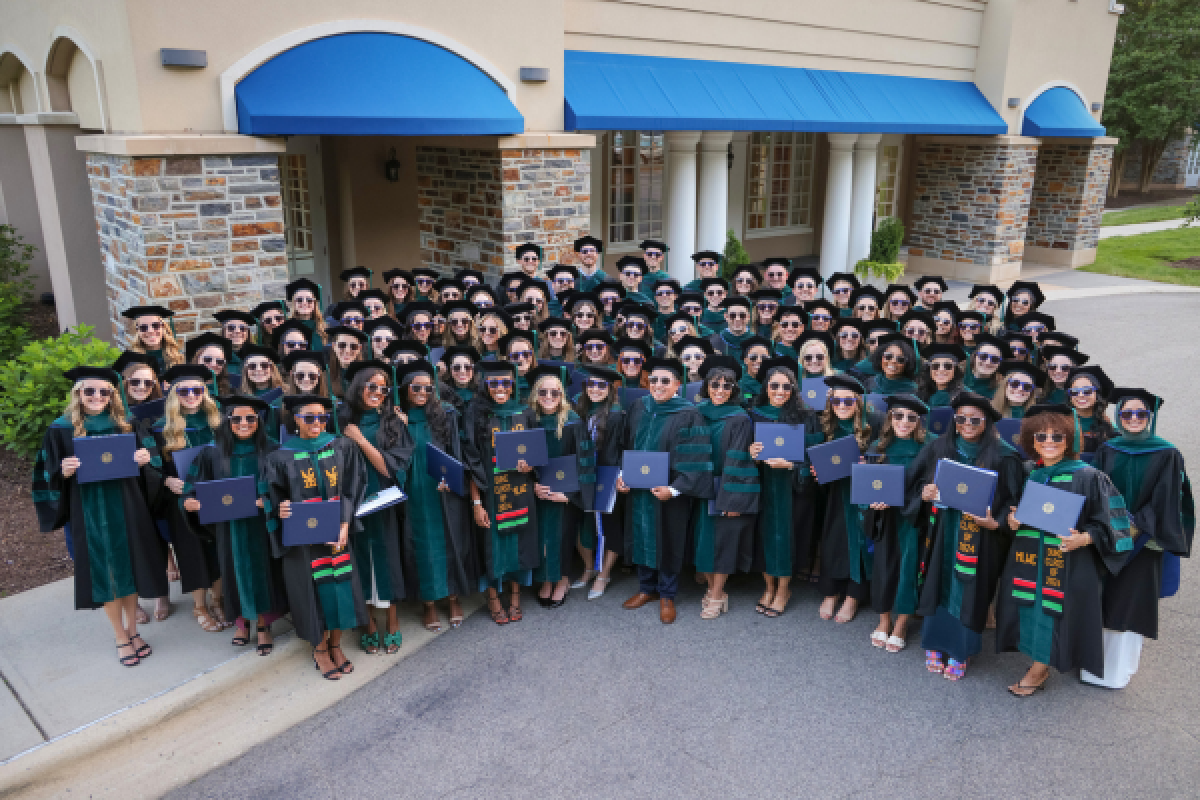
Duke Doctor of Physical Therapy Program Celebrates 80th Commencement

On a Mission to Advance the Profession for Future Generations

Takeaways from the 2024 Branch Lecture
Physical therapy accreditation information.
The Doctor of Physical Therapy Program at Duke University is accredited by the Commission on Accreditation in Physical Therapy Education (CAPTE), 3030 Potomac Avenue, Suite 100, Alexandria, Virginia 22305-3085 | 703-706-3245 | [email protected] | http://www.capteonline.org. To contact the program directly, please call 919.681.4380 or email [email protected] .
Follow Us on Social Media!
© COPYRIGHT 2024 Duke Doctor of Physical Therapy. All Rights Reserved. Privacy Policy Notice of Nondiscrimination Aviso de no Discriminacion
How to Get Into Physical Therapy Schools
Applicants to PT programs need to demonstrate empathy and an interest in physical therapy, experts say.

Getty Images
The federal Bureau of Labor Statistics predicts the number of employed physical therapists in the U.S. will be 22% higher in 2028 than 10 years prior.
People who suffer traumatic injuries often face a difficult journey to recovery. They might struggle to walk or have other mobility challenges, and they could feel significant pain. These are situations where a physical therapist , or PT, can provide critical assistance.
This kind of health care professional is an expert on diagnosing and counteracting mobility problems. He or she can offer hands-on therapies and prescribe exercise regimens.
Though graduate education wasn't always required to become a physical therapist, a doctorate degree is now necessary to join the profession in the U.S. An aspiring U.S. physical therapist will need to complete a Doctor of Physical Therapy degree, or DPT, which typically requires about three years of full-time study.
He or she will also need to pass the national physical therapy exam, or NPTE, and obtain a license to practice in the state where he or she intends to work.
Physical therapists sometimes choose to pursue further education after they complete a DPT program by obtaining a residency, fellowship or board certification within a particular physical therapy specialty, such as women's health, neurology or clinical electrophysiology.
The number of job opportunities in this field is growing, according to the federal Bureau of Labor Statistics, which predicts that the number of employed physical therapists in the U.S. will be 22% higher in 2028 than 10 years prior. In 2018, the median annual salary among physical therapists was $87,930, the bureau reports.
The average debt burden among newly minted DPT graduates is often significant. For example, the average debt-to-income ratio among Florida early-career physical therapists surveyed in 2016 was 197% – equal to almost two years of the average salary, according to student debt research published by the American Physical Therapy Association, or APTA.
Nevertheless, some young physical therapists say that they are glad they invested in their education, despite the cost.
"I have student loans that I pay on every month, and I probably will for forever or for the foreseeable future, but I love what I do, so it kind of just is what it is," says Lauren Lobert, who received her DPT degree from the University of Michigan—Flint in 2012 and owns APEX Physical Therapy Practice in Brighton, Michigan.
Lobert says her PT job allows her to assist people in need in a tangible way, and she finds physical therapy a fulfilling and meaningful profession. "You get to work with people through injuries or through some of the hardest times in their lives," she says, adding that she enjoys building relationships with patients.
The physical therapy field is ideal for highly active people who like to move around, she adds, because PTs don't spend a lot of time "sitting behind a desk."
What It Takes to Become a Physical Therapist
The abilities to empathize and communicate well are essential for success as a physical therapist, according to individuals working in the field.
"Physical therapy is a personal profession," Morgan Nolte, a board-certified clinical specialist in geriatric physical therapy, wrote in an email. "You have to be able to connect with people, talk to people, and exhibit a true interest in helping others. Community service and leadership experience can help you further stand out from the crowd," adds Nolte, who has a DPT degree.
It is also imperative to commit to lifelong learning, says Chalee Engelhard, director of the DPT program at the University of Cincinnati , where she is also an associate professor.
Another important quality for an aspiring physical therapist to have is resilience, Engelhard says. When patients are unable to meet their mobility goals, physical therapists need to calmly assess the situation and figure out a solution, she adds.
Craig Stiemsma, a professor at Dordt University in Iowa and director of its pre-physical therapy club, says anyone who is considering a physical therapy career needs to assess whether he or she enjoys working with people and solving problems, since both of those activities are central components of physical therapy jobs.
They should then observe physical therapists in action to gauge whether the profession is a good fit, Stiemsma says.
Field experience can help prospective students determine whether physical therapy is the right calling before they enroll in the prerequisite courses that are mandatory for admission to a particular PT school, Stiemsma adds.
According to the APTA, completing college classes in the following academic disciplines is often necessary in order to qualify for acceptance into a PT program:
"You are not required to select a particular major in order to be eligible for admission to a PT program," the association states in its online guide to the PT school admissions process. "The most common undergraduate majors among PT students include exercise science, biology, kinesiology, and psychology."
The association adds that PT school hopefuls may need to complete a certain number of hours of PT-related fieldwork to be competitive candidates; meet GPA and GRE requirements; get references and participate in interviews; disclose if they have any criminal convictions; and undergo criminal background checks and drug screenings.
Additionally, some PT schools prefer in-state students and may require that candidates demonstrate certain physical, behavioral or cognitive abilities that they deem necessary to complete a DPT degree and excel as a physical therapist, according to the association.
Stiemsma advises aspiring physical therapists to look up the typical grades and test scores among admitted students at their target program and attempt to exceed the average. Having exceptional credentials will boost the odds of acceptance, he emphasizes.
There are significant nonacademic considerations in the PT school admissions process, notes Nolte, who owns a Nebraska-based physical therapy practice – Reshape Physical Therapy and Wellness LLC – and serves as an academic coordinator for the geriatric physical therapy residency at Creighton University in Nebraska. "Going out of your way to get observational experience, or better yet work experience, in settings where physical therapy takes place will set you apart."
Eric J. Hegedus, a professor and founding chair with the DPT department at High Point University in North Carolina, says his school uses a holistic admissions process that accounts for more than numbers, adding that they use interviews to screen applicants.
"We want to see how the applicant interacts and communicates, see their passion for physical therapy, and hear their story," Hegedus wrote in an email.
Jasmine Marcus, a physical therapist in Ithaca, New York, who received her DPT degree from Columbia University , says a solid application essay helped her stand out in the PT school admissions process. "The best thing that you can do is just try to stand out a little bit," she says.
Marcus notes that many PT admissions essays discuss the incident that precipitated the candidate's interest in the PT profession. However, that approach will often be dull and "generic" if it recounts an everyday physical therapy treatment session, she says.
"You're describing something that the person reading it isn't going to be very interested in and that hundreds of other people could have described as well, so I usually recommend that you write about something that's just going to show off who you are as a person," she says.
The essay should highlight traits about a PT school applicant that would make him or her a good physical therapist, she adds, suggesting that the essay topic doesn't need to be physical therapy. She says her own application essay focused on how her communication skills as a former journalist and writer would translate well into the PT field, where questioning and understanding patients is vital.
"So I kind of took my strengths and how I was unique but also spun it in a way that showed why I would make a good future physical therapist," Marcus explains.
What's Taught In Physical Therapy School
Hegedus, who has a DPT degree, suggests that PT school is similar to other types of health care professional programs in its rigor, but he notes that it differs in important ways.
In contrast to other health care grad programs , during PT programs "you must learn and apply (rather than memorize and regurgitate)," and you gain expertise in how the way someone moves can contribute to their pain and aggravate their disabilities, he says.
Alice Holland, who received her DPT degree from the University of Southern California , wrote in an email that PT school is exceptionally demanding and often involves back-to-back classes.
"The first year of DPT school is very anatomy-heavy with cadaver work, the second year is focused on neurobiology and the third year is bringing all knowledge together to form treatment plans," says Holland, who started an outpatient orthopedic physical therapy clinic, Stride Strong Physical Therapy LLC, and has hired PT school grads.
She adds that DPT students typically participate in internships at PT clinics, which allows them to gain relevant work experience and begin to interact with patients.
Searching for a grad school? Access our complete rankings of Best Graduate Schools.
Grad Degree Jobs With $100K+ Salaries

Tags: physical therapy , graduate schools , students , education
You May Also Like
Get accepted to multiple top b-schools.
Anayat Durrani May 16, 2024

Premeds and Emerging Medical Research
Zach Grimmett May 14, 2024

How to Get a Perfect Score on the LSAT
Gabriel Kuris May 13, 2024

Premeds Take 5 Public Health Courses
Rachel Rizal May 7, 2024

Fortune 500 CEOs With a Law Degree
Cole Claybourn May 7, 2024

Why It's Hard to Get Into Med School
A.R. Cabral May 6, 2024

Pros, Cons of Unaccredited Law Schools
Gabriel Kuris May 6, 2024

An MBA and Management Consulting
Sammy Allen May 2, 2024

Med School Access for Minority Students
Cole Claybourn May 2, 2024

Different jobs with med degree
Jarek Rutz April 30, 2024

How to Become a Physical Therapist

Genevieve Carlton
Contributing Writer
Learn about our editorial process .
Updated September 18, 2023
TheBestSchools.org is an advertising-supported site. Featured or trusted partner programs and all school search, finder, or match results are for schools that compensate us. This compensation does not influence our school rankings, resource guides, or other editorially-independent information published on this site.
Are you ready to discover your college program?
Physical therapists help athletes recover from injuries, treat patients with chronic back pain, and specialize in rehabilitation. A key part of the healthcare system, physical therapists benefit from high demand. The field reports median salaries more than double the median for all occupations and much-faster-than-average job growth.
In every state, physical therapists must meet education and training requirements to practice. Our guide covers how to become a physical therapist, including education requirements, common specializations, and licensure requirements. Prospective physical therapists can use these resources to learn more about the career path.
Questions About Physical Therapy
How long does it take to become a physical therapist.
Physical therapists must complete a three-year doctoral program to qualify for a license. Some schools offer a 3+3 accelerated program. In them, students spend three years earning an undergraduate degree before directly entering the doctoral program.
Is a physical therapist a doctor?
Yes, physical therapists are doctors. They complete a doctorate as part of their training. However, physical therapists do not attend medical school. Instead, they train in doctor of physical therapy (DPT) programs.
What is the difference between a chiropractor and a physical therapist?
Chiropractors focus on the nervous system and correct related pain. Physical therapists specialize in many body systems, including the musculoskeletal system. They emphasize stretching and exercises to build strength.
Do physical therapists make a lot of money?
According to the Bureau of Labor Statistics (BLS), the median annual physical therapist salary is $91,010. That exceeds the median salary for healthcare practitioners of $69,870.
What Do Physical Therapists Do?
Physical therapists count themselves among many different types of therapists in the healthcare field. They treat patients recovering from an injury or surgery. Physical therapists provide preventative treatments and help patients with chronic illnesses.
When meeting with a new patient, physical therapists review their medical history and diagnose their needs. Then, physical therapists design a treatment plan. They work closely with patients to demonstrate therapeutic techniques and equipment that increase mobility and decrease pain.
Physical therapists educate patients on their recovery and modify care plans based on progress. They often specialize in areas like orthopedics, geriatrics, or sports physical therapy. Physical therapists work in physical therapy offices, hospitals, home healthcare services, and residential care facilities.
Physical therapist jobs require strong communication skills, compassion, and patience. Physical therapists lift and adjust patients, so they need physical stamina and fitness as well. The career often means long hours standing and working closely with patients.
What Are the Education Requirements for Physical Therapy?
Students who want to become a physical therapist need to understand the education requirements for physical therapist jobs. Recently, the field increased those requirements. Physical therapists once only needed a bachelor's or master's, but now the field requires a doctorate. This section walks through the degrees you'll need to become a physical therapist.
Associate Degree
An associate degree prepares graduates for careers as a physical therapist assistant . During an associate program, students learn about human anatomy, physiology, and kinesiology. They take classes in biology and math. Programs incorporate clinical training to strengthen career-ready skills.
Learners who complete an accredited physical therapist assistant program can apply for a physical therapist assistant license or certification. A two-year associate degree in any subject prepares students to transfer into a bachelor's program. Associate degree-holders can transfer to a four-year institution and earn a bachelor's in about two years.
Bachelor's Degree
A bachelor's degree prepares prospective physical therapists for graduate-level training. What majors should prospective physical therapists consider? Common physical therapist majors include biology, kinesiology, psychology, and exercise science.
These majors often meet the prerequisite course requirements for graduate programs. Most DPT programs require courses in anatomy, physiology, biology, chemistry, physics, psychology, and statistics. Future physical therapists major in all fields, including humanities, healthcare, or social service. However, they will need to meet the prerequisites to gain admission to a graduate program.
Earning a bachelor's degree generally takes four years for full-time students. The cost varies depending on the school. Undergraduates spend $9,350-$32,770 in tuition and fees , according to 2019-20 National Center for Education Statistics data.
Master's Degree
In the past, physical therapists qualified for licensure with a master's degree. Today, they need a doctorate. Does it make sense to earn a master's degree to become a physical therapist?
Some students benefit from a master's degree. A master's program may help undergraduates with a low GPA or those who need to meet prerequisites. Since most physical therapy programs no longer offer a master's, a degree in kinesiology or occupational therapy can help DPT applicants stand out.
Most master's programs take two years. The cost of a master's degree varies, with most programs costing $30,000-$120,000.
Doctorate Degree
Physical therapists need a doctorate to get their license and practice. Most physical therapy doctoral programs take three years. During that time, doctoral students complete coursework in anatomy, physiology, biomechanics, and kinesiology. Programs incorporate training in the behavioral sciences, evidence-based practice, and multiple body systems.
Besides classroom training, doctoral students complete a clinical education component. The 25-30 weeks of clinical training prepare physical therapy graduates for residencies and physical therapist jobs.
DPT program costs vary. In general, public universities with in-state tuition discounts cost less than private institutions. Some programs offer accelerated or part-time enrollment options.
Physical Therapy Specializations
During a physical therapy doctoral program, graduate students choose a specialization to focus their training. After completing a doctorate, physical therapists can pursue board certification as a clinical specialist in 10 specialty areas.
The American Board of Physical Therapy Specialties (ABPTS) offers board certification in geriatrics, orthopedics, and pediatrics. They also certify physical therapists specializing in cardiovascular and pulmonary issues, oncology, sports physical therapy, and women's health.
This section introduces the requirements for three popular physical therapy specializations. Degree-seekers wanting to become a physical therapist can research programs offering concentrations in their desired area. Then, with a doctorate, they can earn board certification as a clinical specialist.
Orthopedic Clinical Specialist
Orthopedic physical therapists treat injuries to patients' bones, muscles, and joints. The specialty requires coursework in orthopedic injuries and musculoskeletal disorders. Enrollees learn about conditions like arthritis that affect the skeletal system, as well as injuries and surgical procedures that require physical therapy.
Board certification requires 2,000 hours of direct patient care in orthopedics. Candidates must complete an orthopedic residency with an accredited institution.
Geriatric Clinical Specialist
A geriatrics specialization focuses on aging patients who require physical therapy. To prepare for physical therapist jobs in this specialty, students learn about age-related musculoskeletal disorders, including arthritis and osteoporosis. They also learn about neurological disorders that affect physical health. Doctoral candidates gain hands-on experience through clinical practicums.
After completing a doctorate with training in geriatrics, physical therapists must meet two requirements for board certification. Candidates need 2,000 hours of patient care in geriatrics and an accredited geriatrics residency.
Pediatric Clinical Specialist
Physical therapists specializing in pediatrics work with children and adolescents. They focus on physical injuries and disorders that affect young people from birth through their teenage years. During a doctoral program, a pediatric concentration covers conditions that pediatric physical therapists treat, like cerebral palsy. Doctoral candidates complete clinical hours in pediatric care settings.
Professionals qualify for pediatric clinical specialist board certification with a doctorate, accredited pediatrics residency, and 2,000 pediatric patient care hours.
Career and Salary Outlook for Physical Therapy
Physical therapists benefit from a strong career and salary outlook. Salaries vary depending on location, experience, and industry. The top-paid physical therapists earn a median salary over $126,500 per year.
Some industries report a higher physical therapist salary than others. Nursing and residential care facilities report the highest median pay, followed by home healthcare services, hospitals, and physical therapist offices.
Location also affects earning potential. The five states with the highest mean physical therapist salary are Nevada, California, Alaska, New Jersey, and Connecticut. In these states, physical therapists report mean salaries over $100,000 per year.
In addition to high earnings, the field reports a strong job outlook. The BLS projects 49,100 added physical therapist jobs from 2020-2030, representing 21% projected job growth. This qualifies as much-faster-than-average growth.
Certifications and Licensure for Physical Therapists
In every state, physical therapists need a license to practice. Requirements vary by state, but include a doctorate from an accredited program. Candidates must pass the National Physical Therapy Examination , which tests their knowledge in many areas of physical therapy.
Physical therapists pursuing licensure in some states must pass a jurisprudence exam.Other requirements may include a criminal background check. The Federation of State Boards of Physical Therapy provides contact information for each state's licensing body. It also offers information on the exam requirements for licensure.
With a state-issued license, professionals qualify to apply for physical therapist jobs. They can also pursue board certification in a specialty area through ABPTS. Board certification requires a residency and clinical patient care hours.
Ask an Expert

Lea Klein graduated from St. Louis University with a bachelor's in exercise science in 2000 and received her master of science in physical therapy in 2001. She began by working in outpatient care, treating orthopedic impairments. During her almost 20-year career, Klein became passionate about treating pregnant and postpartum patients and decided to go through training to treat pelvic floor disorders in 2007.
She now specializes in pelvic floor physical therapy. In 2017, after having her third child, she decided to take the leap and start her own private business, Klein Physical Therapy . Klein always wanted to deliver the highest quality care and felt that one-hour sessions allowed for quicker progress. Her practice continues to grow steadily.
Q. What Are Some Challenges and High Points in This Role?
I feel like the highest points of being a physical therapist (PT) are the times when you have made tremendous progress with a patient and truly changed their current life. There is nothing better than hearing that they are no longer experiencing the debilitating pain they had been experiencing or that they could resume their exercise routine without pain.
The challenges in this role are the limits that insurance companies place on quality care. Another challenge is breaking the stereotype of what a PT does. Our profession has grown tremendously, and many still don't know about all the benefits of seeing a PT. My specialty of pelvic floor physical therapy is still not well known.
Q. What Type of Person Does Well in This Role?
There are many different settings for a physical therapist to explore. Being a neurophysical therapist treating patients with traumatic brain injury, for instance, is very different than being an outpatient orthopedic therapist. The common characteristic in all specialties is being a caregiver. You have to like working closely with people, and it's a plus if you're an analytical thinker who likes to problem solve.
Q. Who Does This Role Help? How Does This Role Affect Others?
This role helps a tremendous amount of people. It really helps anyone struggling with physical impairments. In the neuro world, you are helping stroke patients, Parkinson's patients, patients with closed head or spinal cord injuries, and many others. In the ortho world, you are helping post-surgical patients, such as those recovering from a total knee replacement or rotator cuff repair. The patient with debilitating low back pain and the postpartum mom struggling with urinary incontinence and sciatica are all examples of those helped by physical therapy.
Q. Why Do We Need More Physical Therapists?
Physical therapy is a crucial profession. As baby boomers get older and the weekend warriors continue to injure themselves, we continue to need more physical therapists.
Q. How Long Does It Usually Take Graduates With a Degree to Get Hired?
Most graduates who have prepared themselves can get hired immediately after graduation. My first job was with the company that I had one of my clinicals with. I secured the job before I even passed the boards (barring that I passed, of course).
Q. How Much Does a Certification Specialty Affect Your Hireability?
As a new grad, it is not necessary to have a certification specialty to be hired. My personal advice is to stay focused during your schooling on which area of PT you'd like to practice in. Make sure you sign up for a variety of clinical settings and then go for your favorite setting when you graduate.
As you begin to work in that setting, then strive to specialize in something more specific. A specialty is likely going to make you a more desirable candidate when applying for positions.
Q. What Skills Do Employers Look For?
I believe employers are looking for therapists who are good communicators and those who are teachable. One must show the ability to perform critical thinking. If you have an openness to learn and you are confident without being arrogant, you will shine in an employer's eyes.
Q. What Can Students Do to Make Themselves Look Better to Employers?
Students will always look better if they demonstrate that they are truly invested in their profession. Taking the time to volunteer within the profession and having strong personal and professional goals for growth are ways to stand out.
Resources for Physical Therapy
Header Image Credit: Erik Isakson | Getty Images
Popular with our students.
Highly informative resources to keep your education journey on track.
Take the next step toward your future with online learning.
Discover schools with the programs and courses you’re interested in, and start learning today.
How to Become a Physical Therapist
Featured articles.
Easiest Online RN-to-BSN Programs to Get Into
Best BSN to DNP Programs | Online Options 2024
Top Direct-Entry Master's in Nursing (MSN) Programs

Physical therapists (PTs) are healthcare practitioners who help patients improve their movement abilities. They do this through exercise, stretching, hands-on treatments, and the use of various devices and equipment. In addition to improving mobility, a PT helps manage and relieve pain caused by injuries, disabilities, or other illnesses.
The healthcare services PTs provide can drastically improve the quality of their patient’s lives. If working one-on-one with patients in a medical environment interests you, becoming a physical therapist might be a great career option.
This article will provide a complete overview of everything you need to know about being a physical therapist, including what they do, salary information, how to become one, education requirements, career outlook, and more!
We Found The Following Schools with Online Physical Therapy Aide Programs
Part one what is a physical therapist.
Physical therapists are healthcare professionals who work one-on-one with patients experiencing mobility challenges and pain. Patients are usually referred to physical therapists by physicians after being diagnosed with a medical condition. But physical therapists also conduct their own physical examination to understand the patient’s overall condition better. From there, they craft a personalized treatment plan.
PTs have expertise in a variety of bodily systems. Most of their work involves the musculoskeletal system. However, it can also include neurological, cardiopulmonary (heart and lung), and integumentary (skin) systems.
Physical therapists also teach exercises appropriate to their patient’s condition and use equipment and other hands-on techniques to provide relief and speed healing. Some of the benefits that a PT can provide their patient with include:
- Restoring range of motion
- Improving balance and posture
- Boosting strength, coordination, fitness, and mobility
- Addressing physical issues induced by obesity
- Assisting with chronic problems such as back pain
- Educating and empowering patients with exercises and stretches to improve healing on their own
The exercises, stretches, manual therapy, and body mechanic lessons a PT introduces can also prevent sports injuries and enhance athletic performance.
PTs often work within a multidisciplinary team of other healthcare professionals, including physical therapy assistants (PTAs), nurses, and physicians. They also may help teach occupational therapy movements to ensure patients can perform activities of daily living at home.
Part Two What Do Physical Therapists Do?
Physical therapists are experts in movement and range of motion. They help injured or disabled people of all ages enhance their physical abilities with a combination of exercise, education, and hands-on care.
They may also work with individuals who, though generally healthy, seek assistance in enhancing overall wellness and achieving their fitness goals.
Physical Therapist Responsibilities
Physical therapists start by examining the patient. From there, PTs can facilitate a treatment plan tailored to the patient’s needs. Some of the patient care responsibilities and duties they perform also include:
- Reviewing patients’ medical histories and current symptoms
- Observing patients’ movements
- Devising treatment plans
- Sharing goals and anticipated outcomes with patients
- Demonstrating and assigning exercises and stretches to do at home
- Using hands-on therapy and equipment to increase mobility and function
- Recording patient progress
- Modifying treatment plans as needed
Physical Therapist vs Occupational Therapist: What's the Difference?
The main difference between physical and occupational therapy is that physical therapists work on improving how well patients can move their bodies. Conversely, occupational therapists focus on improving how well patients perform daily tasks. Though subtle, these differences impact physical vs occupational therapy goals, approaches, and treatment plans.
Check out our comprehensive guide to learn more about how to become an occupational therapist .
Where Do Physical Therapists Work?
You can find PTs working in a variety of healthcare environments, including:
- Nursing homes
- Sports and fitness facilities
- Outpatient clinics
- Private practices
- Home health agencies
- Workplaces
Physical Therapist Specialties
PTs may specialize in different treatments or conditions, including oncology, orthopedics, or sports medicine. They also work with diverse patient populations - from pediatrics to geriatrics.
Part Three Physical Therapist Salary
According to the Bureau of Labor Statistics , the median annual wage for physical therapists in May 2020 was $91,010, or $43.75 per hour. The highest 10 percent in the profession earned more than $126,780.
Highest Paying States for Physical Therapists
The states that pay the highest mean annual salary are:
- California - $114,230, or $54.92/hr
- Nevada - $105,880, or $50.90/hr
- New Jersey - $105,430, or $50.69/hr
- Alaska - $104,470, or $ 50.23/hr
- Connecticut - $103,920, or $49.96/hr
Physical Therapist Salary Factors
Many other factors determine salary, including your level of education and years of experience. Most physical therapists are employed full-time and receive additional benefits, including paid time off, health insurance, and tuition reimbursement.
Part Four How to Become a Physical Therapist
If you want to become a physical therapist, you’ll have to earn both:
- A bachelor’s degree in a science-related field, and
- Complete a Doctor of Physical Therapy (DPT) program with accreditation from the Commission on Accreditation in Physical Therapy Education (CAPTE)
Physical Therapy Degree Programs
Doctor of Physical Therapy programs generally take three years to complete. There are two ways to get your DPT education.
DPT Option #1: Bachelor’s Degree to DPT Program
The most common route involves earning a 4-year bachelor’s degree in a science-related field. Undergraduate majors most common for those who go to a DPT program include kinesiology, biology, or exercise science.
Then students can apply for and complete a DPT program. This route takes a total of seven years.
DPT Option #2: Accelerated DPT Program
Attend an accelerated 3+3 curriculum or freshman entry program. This route provides three years of required undergraduate courses followed by a three-year DPT program.
This option can be an excellent route for students who already know that they want to become a PT upon graduating from high school. These programs often guarantee admission into a DPT program following the successful completion of specific undergraduate courses. These programs take a minimum of 6 years to complete.
DPT Application Process
The American Physical Therapy Association created the Physical Therapist Centralized Application Service to facilitate the application process. This simple web-based application takes one completion and then is used to apply to multiple accredited programs.
DPT Coursework
PT coursework will include classroom education in the following subjects:
- Behavioral science
- Biomechanics
- Kinesiology
- Neuroscience Pharmacology
- Pulmonary system
- Cardiovascular system
- Endocrine and metabolic systems
- Musculoskeletal systems
- Communication
- Evidence-based practice
Students will also spend a minimum of 27 weeks gaining hands-on clinical experience as a part of their studies.
Physical Therapy Licensure
After completing a DPT program, graduates must pass a state licensure exam required by their state before practicing as a professional. Every state has its own licensing and continuing education, and it is essential to research your state’s requirements.
Part Five What is the Career Outlook for Physical Therapists?
The BLS projects that opportunities for physical therapists will grow by 18% over the next several years.
Several factors are responsible for the increased projected job openings, including:
- Increased use of outpatient surgery followed by rehabilitation and therapy
- A greater understanding of the impact that therapeutic protocols can have on the disabled and victims of trauma
- The aging of the baby boom generation leading to more required interventions
- Expanding interest in improving health, mobility, and function on the part of the general public.
Physical therapy can address all of these needs, improving quality of life and helping people live healthy and active lives.
Part Six What are the Continuing Education Requirements for Physical Therapists?
Every state has its own licensing board that regulates physical therapists. States also have independent policies and procedures related to continuing education requirements.
The Federation of State Boards of Physical Therapy (FSBPT) maintains a list of each state’s licensing authorities, including links to each state’s practice act.
Part Seven Where Can I Learn More About Becoming a Physical Therapist?
Several professional PT organizations provide resources about career opportunities, events, and more, such as:
- American Physical Therapist Association (APTA)
- American Council of Academic Physical Therapy (ACAPT)
- American Academy of Orthopaedic Manual Physical Therapists (AAOMPT)
- World Confederation for Physical Therapy (WCPT)
Part Eight Physical Therapist FAQs
what does a physical therapist do.
- Physical therapists work one-on-one with patients to improve mobility and function and to relieve pain. The individuals that they treat may be recovering from illness, disabled by congenital disabilities, suffering from injuries, experiencing neurological traumas, or other debilitating physical conditions.
How many years does it take to become a physical therapist?
- In most cases, it takes seven years to become a physical therapist. However, some programs offer expedited programs. These programs include a 3-year undergraduate program and a 3-year DPT school.
What is it like to be a physical therapist?
- A career as a physical therapist is both challenging and rewarding. The job can also be physically demanding because PTs provide hands-on treatment and often demonstrate exercises to patients. Most physical therapists enjoy watching their patients make healthy improvements in their quality of life.
How much money does a physical therapist make a month?
- According to the BLS , the average median salary for a physical therapist is $97,720 which equals about $8,143 per month.
Is physical therapy a stressful job?
- Being a physical therapist can be a stressful job. PTs help people during some of the most challenging times of their lives. For example, many patients may be recovering from a debilitating injury or illness and experiencing some suffering. However, the profession can also be rewarding as patients achieve their treatment goals, have pain relief, and gain mobility and function.
Is it hard to become a physical therapist?
- Becoming a physical therapist requires earning an undergraduate degree and pursuing a rigorous three-year Doctor of Physical Therapy program. The course load is challenging and requires at least six to seven years of study. Also, PTs must have excellent communication skills and possess empathy to succeed in the field.

Plus, get exclusive access to discounts for nurses, stay informed on the latest nurse news, and learn how to take the next steps in your career.
By clicking “Join Now”, you agree to receive email newsletters and special offers from Nurse.org. We will not sell or distribute your email address to any third party, and you may unsubscribe at any time by using the unsubscribe link, found at the bottom of every email.
- Partnerships
How To Become A Physical Therapist: 7 Steps
- Bouvé Communications
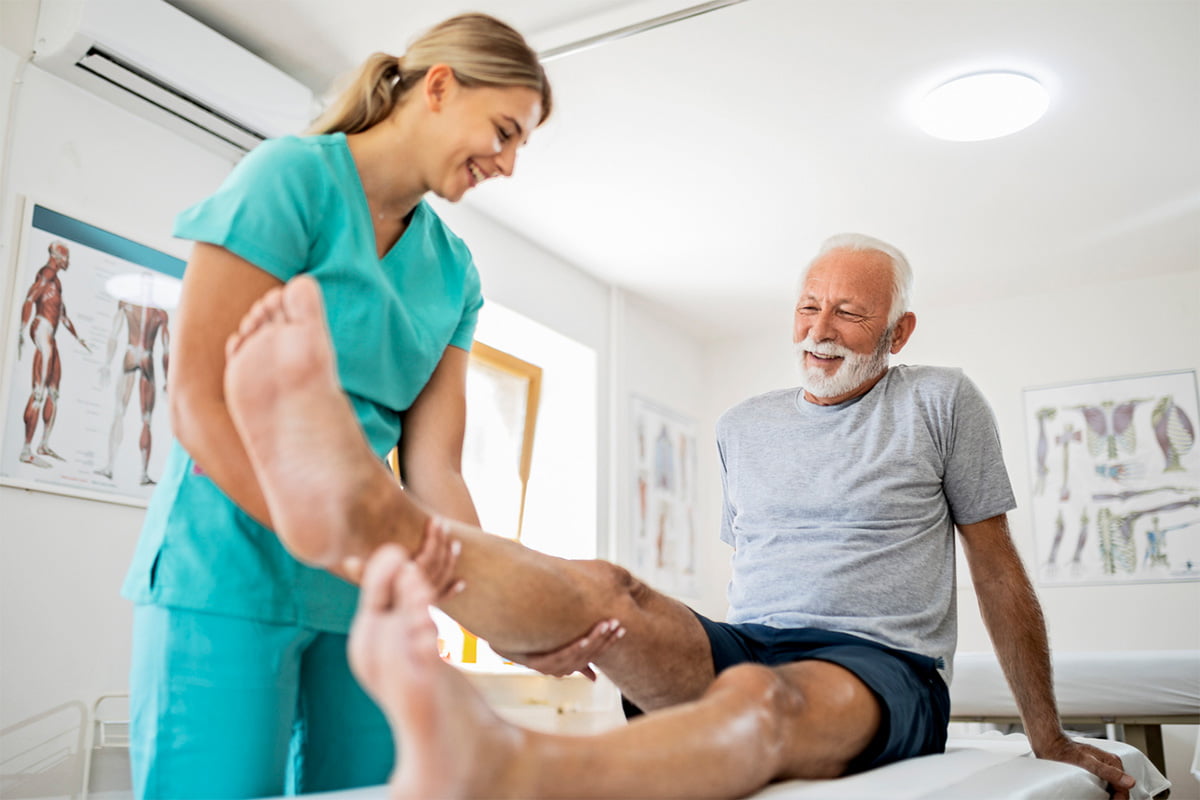
If you or your loved ones have ever recovered from a serious injury or illness, you’ve likely consulted with a physical therapist (PT) for healing and guidance. Physical therapists help people regain strength and reach their rehabilitation goals, providing much-needed support at often a difficult time in patients’ lives. In fact, observing the great work they do may have sparked your personal interest in how to become a physical therapist.
Physical therapy is a broad field that overlaps with nearly every type of healthcare practice. Whether you enjoy helping people recuperate or teaching them how to manage pain, therapeutic careers offer countless ways to make a difference in the lives of others.
Here’s an overview of what physical therapists do, how to become one, and the essential steps to becoming a physical therapist.

What Does a Physical Therapist Do?
“A physical therapist is someone who assists with the pathology of human movement,” says Dr. Christopher Cesario, Associate Clinical Professor and Director of Student Affairs for the Doctor of Physical Therapy (DPT) program at Northeastern University’s Bouvé College of Health Sciences. Patients treated by PTs are typically coping with impaired mobility or a loss of muscular strength with diverse medical needs ranging from children with developmental disorders to seniors rebuilding motor functions after a stroke. Injuries from accidents, work, and sports are also common issues.
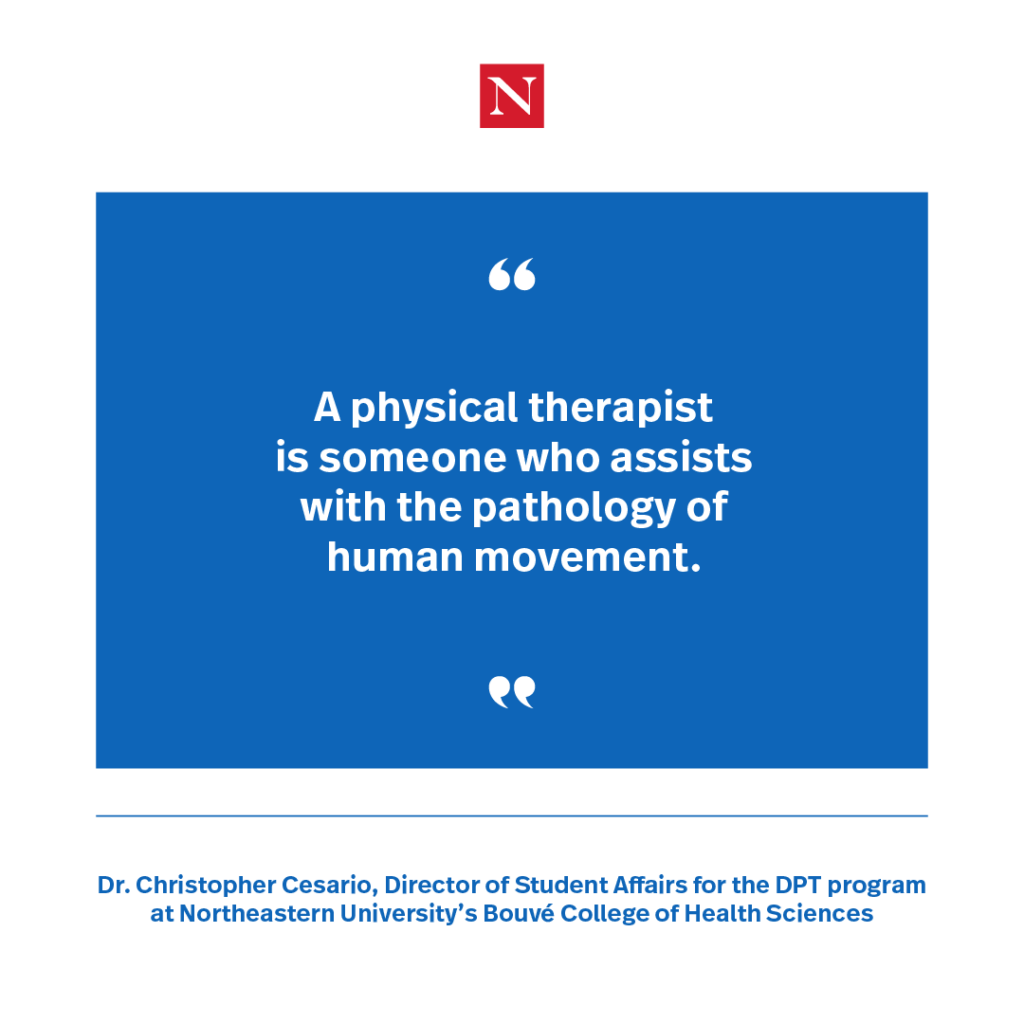
Physical therapists know how to “look at orthopedic, neurological, and cardiovascular issues and help navigate those problems,” says Cesario. Working alongside other healthcare providers, they diagnose physical impairments and create treatment plans around therapeutic exercise to help patients either recover from trauma or adapt to mobility challenges. In addition to having strong clinical experience, PTs must be compassionate and supportive of patients while using their observation and judgment skills to evaluate their needs.
How To Become a Physical Therapist
If you’re a current student or planning to go back to school, you may wonder how long it takes to become a physical therapist. Although physical therapy has a clearly outlined path to licensure, the timeline depends on your professional background, where you are in your education, and whether you can commit to full-time enrollment.
Here’s what to expect when working toward becoming a physical therapist if you have no prior background in this field.
1. Obtain a Relevant Undergraduate Degree
Physical therapist education occurs at the doctoral level, so you must earn an undergraduate degree before you can pursue this career path. While many physical therapy schools require a degree in a related field, having relevant education also increases your competitiveness in programs that don’t require it. Luckily, physical therapy encompasses many topics across the science, health, and fitness disciplines, offering various flexible options.
Acceptable majors vary by program, but some examples include:
- Kinesiology
- Health Sciences
- Exercise Science
Many of the foundational education courses provided in these degree programs can often help accelerate the process of becoming a physical therapist. This is largely because these prerequisite courses are needed in order to advance your education.
2. Determine What Type of Job You Want
By determining the type of job you want in advance, you can make better choices about your educational path and get more value out of a physical therapy program. Physical therapists work with people of all ages who have diverse health goals. As a result, prospective PTs have the opportunity to explore a range of specialties and healthcare environments before graduating.
“I think it’s worth the time to do some observation,” says Cesario. “The general public’s perception of physical therapy is that it’s all orthopedics. And when students find out that there’s physical therapy in a hospital or other settings, it’s kind of enlightening to know that there’s other options.”
With this in mind, try to consider the type of patients you want to work with, conditions you want to treat, and workplace settings you prefer. Some of the healthcare facilities that employ physical therapists are:
- Neurological
- Cardiovascular
3. Obtain a Doctor of Physical Therapy Degree
Earning a Doctor of Physical Therapy (DPT) degree is required to become a physical therapist. While any accredited DPT programs provide the knowledge and clinical experience needed to succeed in this field, it’s important to consider each program’s prerequisite courses. For example, many programs are tailored to students who already have substantial undergraduate credits in the health sciences. In addition, some schools require GRE exam scores, while others do not. As you compare your options, make sure the curriculum is in line with your personal and professional goals, and you can satisfy the admission criteria.
At the same time, keep an open mind throughout your education. Look for physical therapy programs that offer in-depth insight into different disciplines through research labs, simulated clinics, or mentorships. A diversified education, like Bouvé’s Post Baccalaureate Doctor of Physical Therapy degree program , will give you the comprehensive knowledge to evaluate complex medical histories and provide high-quality patient care in a variety of settings.
“We’ve had a trend in recent years where students come in and they’ve already self-identified that they want to be a pediatric, orthopedic, etc. therapist,” says Cesario. “Even if you’re coming into your education with the mentality that you want to do this kind of physical therapy, you still need to understand how the whole body works.”
4. Develop Relevant Skills
Focus on skill-building throughout your education since these competencies are essential for long-term career mobility. According to our analysis of job postings data, the top specialized skills for this career include:
- Rehabilitation
- Treatment planning
- Home health care
- Patient treatment
- Orthopedics
- Discharge planning
- Patient screening/evaluation
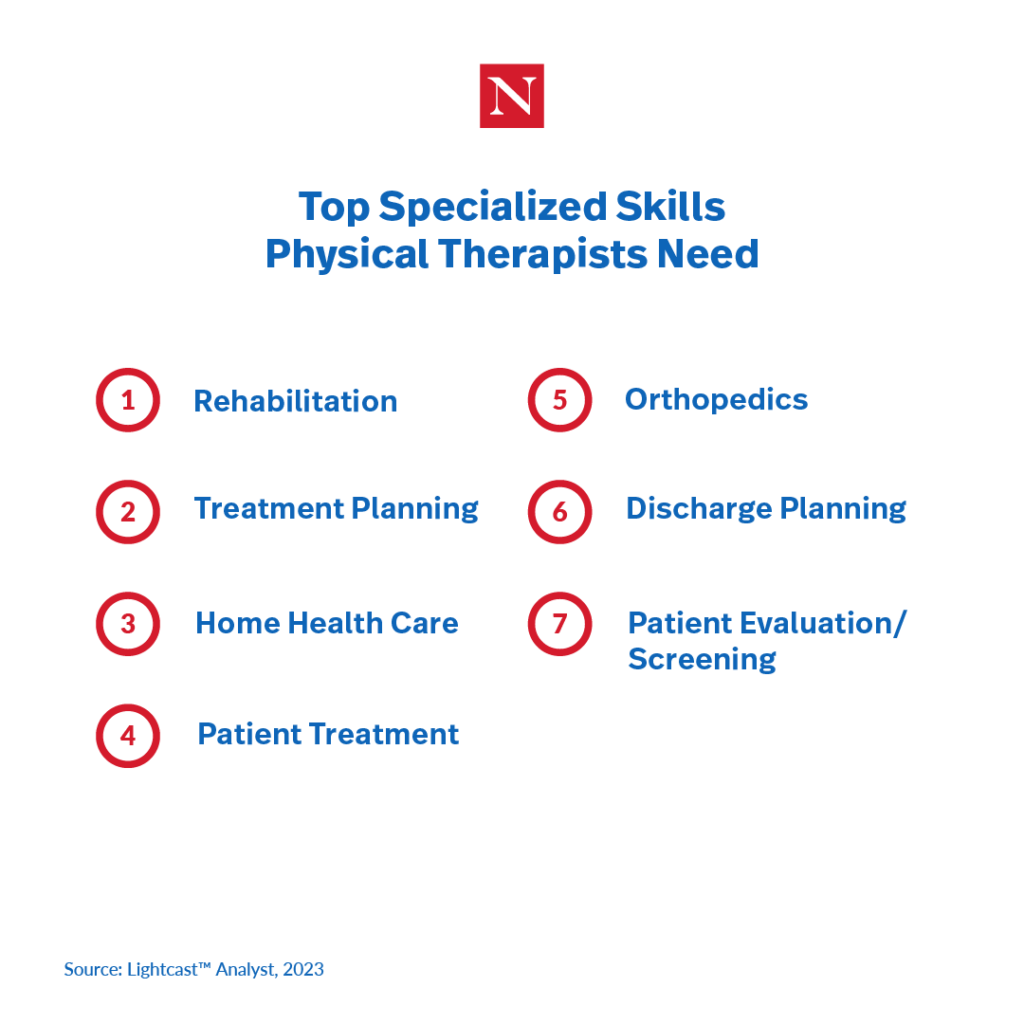
Cesario also believes patient education is another essential skill prospective PTs should develop during their education. “Patient education is something that physical therapists do well and often on a regular basis.”
In addition to technical skills, Cesario urges prospective PTs to work on their soft skills since this is inherently a “service profession.” Being able to effectively communicate, schedule, and educate patients are essential to becoming a better care provider. According to our analysis of job postings data, the top common skills required in this field include:
- Communications
- Coordinating
- Interpersonal communications
- Customer service
- Computer literacy
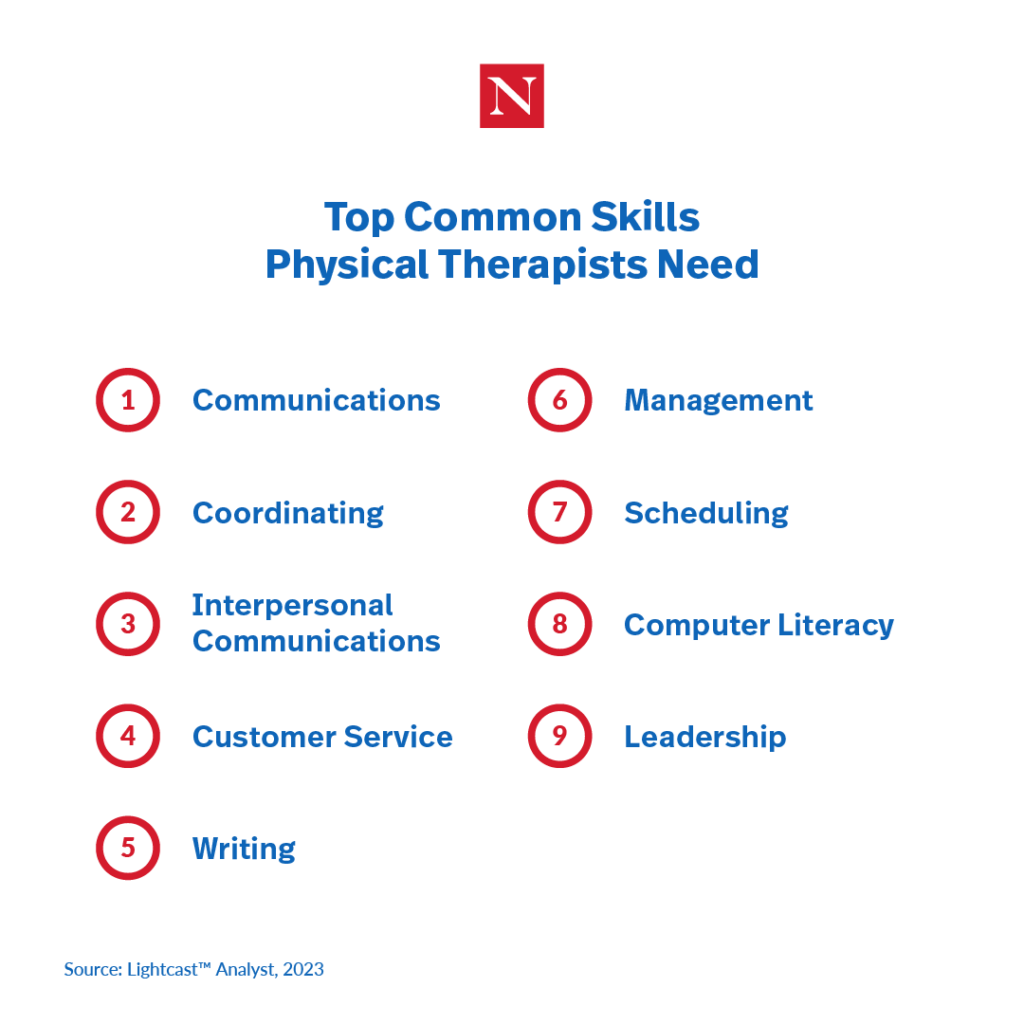
5. Obtain Additional Relevant Qualifications
It’s important to note that completing the required physical therapy education alone doesn’t allow you to immediately start practicing. So, how do you become a physical therapist after earning a DPT degree?
First, it’s essential to understand your state’s licensing requirements for physical therapists. If you plan on moving post-graduation, ensure you check these requirements in the state you hope to work in. Gaining licensure is achieved by passing the National Physical Therapy Examination (NPTE). Many institutions offer assistance throughout this process, but the level of support offered to students to prepare for the NPTE is another factor you should consider when choosing a DPT program.
In addition to these requirements, there are a number of valuable credentials you can pursue to increase your marketability in today’s job market. Here are the top qualifications physical therapists obtain, according to our analysis of job postings data.
Foundational Healthcare Certifications
Having the ability to stabilize someone experiencing a life-threatening emergency is critical for anyone who provides patient care. While these certifications aren’t specific to the field of physical therapy, it’s recommended prospective PTs obtain certification in:
- Basic Life Support (BLS)
- Basic Cardiac Life Support
- Advanced Cardiovascular Life Support (ACLS)
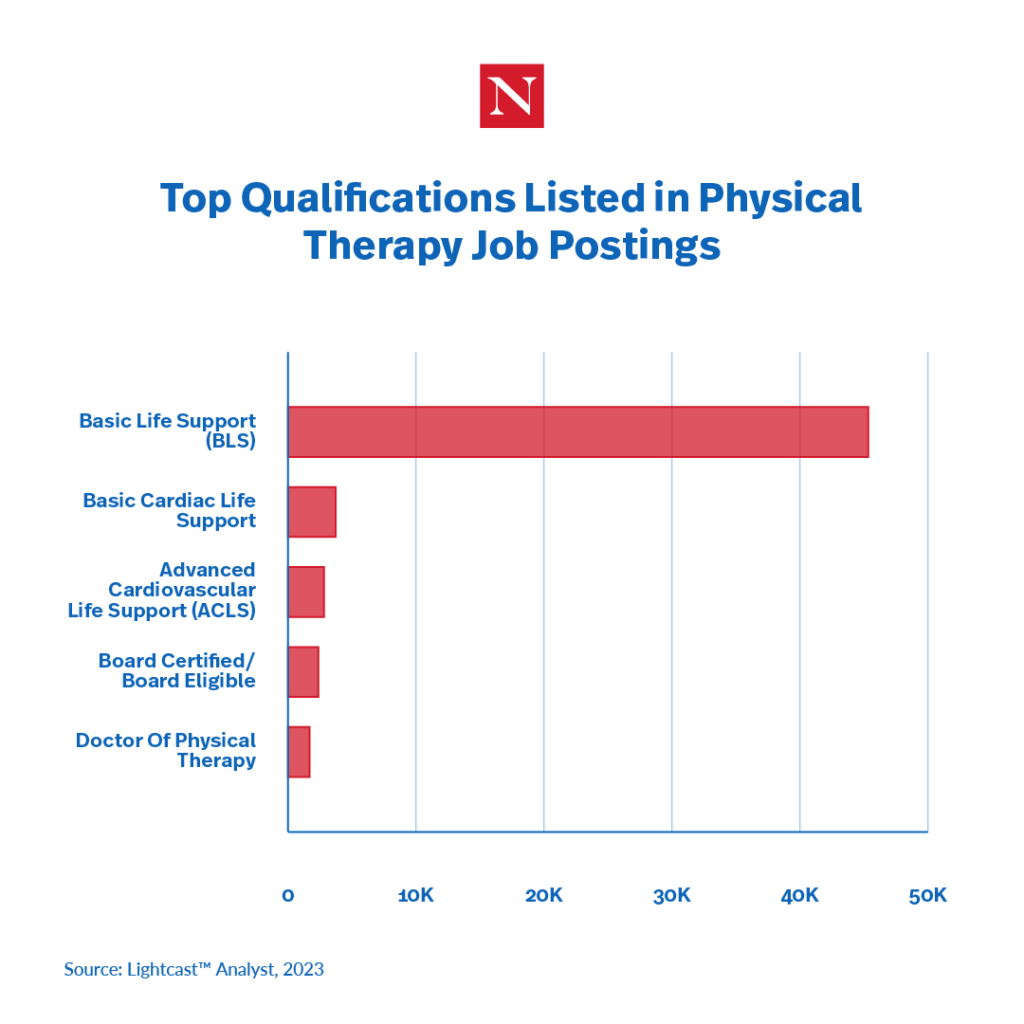
Board Certified/Board Eligible
Getting certified in a clinical specialty advances your knowledge and verifies your expertise. “Board certification is an important qualification to seek out,” says Cesario. “There are a number of opportunities for students to prepare for their boards, including self-preparation and residency programs.” Check out the American Physical Therapy Association (APTA) website to explore the ten specialty certifications they nationally recognize.
6. Build Your Professional Network
Networking before and after you become a PT can make a significant difference in your professional success. As a doctoral student, mentors and peers will be your best resources for developing your skills, researching clinical specialties, finding job opportunities, and understanding the various challenges physical therapists face on a daily basis.
Building relationships with fellow students is also helpful for sharing knowledge and evaluating healthcare from many different perspectives. As you move further into your career, your peers often continue to be a sounding board. Physical therapy involves a lot of observation and adjustment, and other PTs can offer advice and creative solutions based on their diverse experiences on the job. In addition, networking with physicians and other healthcare providers is a time-tested way to get ongoing referrals, especially if you decide to start your own private practice.
7. Gain Professional Experience
Differentiating yourself is challenging when you first start your career, so drawing on past professional experience from reputable sources is essential. Seek out opportunities that show your commitment to learning and growth, whether it’s from internships, mentorships, shadowing, research, or simulation labs.
Choosing the right school is also important because the best DPT programs provide access to critical resources for clinical experience. Physical therapy degree programs that incorporate more experiential learning opportunities in clinical practice will help you feel prepared for real-world environments and demonstrate your proficiency to prospective employers.
Start Your Career in Physical Therapy
If you’re ready to become a physical therapist, enrolling in Northeastern’s Bouvé College of Health Sciences’ Post Baccalaureate Doctor of Physical Therapy degree program is a great way to jumpstart your new career. The faculty consists of board-certified experts with years of experience in clinical specialties—most of them currently practicing therapists with a pulse on today’s industry trends.
Physical therapy students have ongoing opportunities to network and put their skills into action through internships and co-ops. Northeastern University employs an experiential learning model that centers the curriculum in real-world applications, continually encouraging students to think strategically about patient care. To learn more about what the DPT program has to offer, you can contact an admissions counselor and even connect with current students to find out if this degree is right for you.
Download Our Free Guide
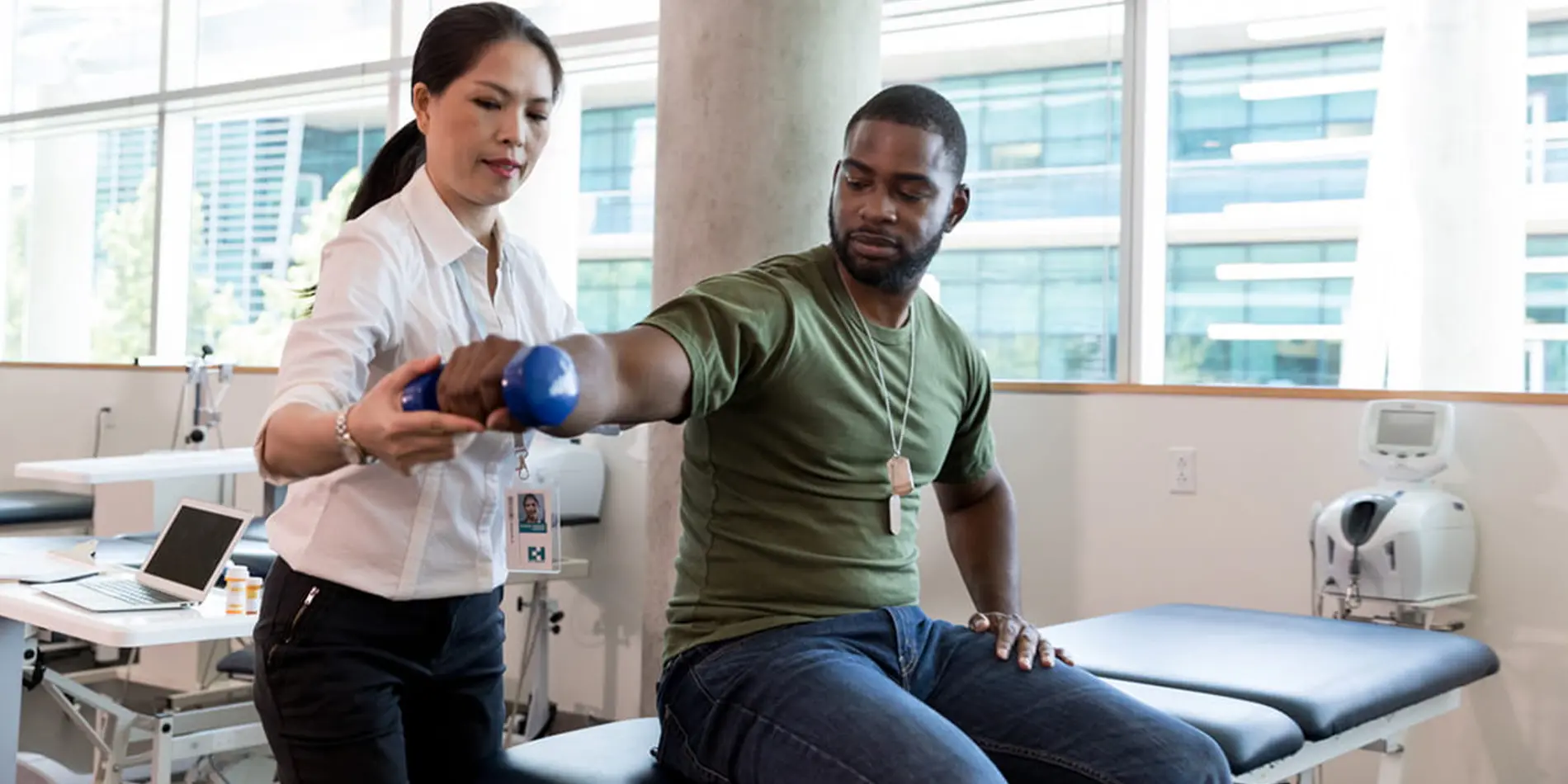
Career Guide
Everything You Need To Know About Becoming a Physical Therapist

Related Articles

Yoga shows ‘most improvement’ in restoring brain health in long-term cancer survivors, Northeastern researcher says

Celebrating 40 years of the John W. Webb Lecture Award

‘Challengers’ is where tennis meets love. But what happens in real life if you date someone in your field?

Connect with us
Have more questions about Bouvé? We’re here to help.
Want to take the next step and start your journey at Bouvé?
Request more information
Interested in learning more about what Bouvé has to offer?
- Student/Faculty Portal
- Learning Hub (Brightspace)
- Continuous Professional Development
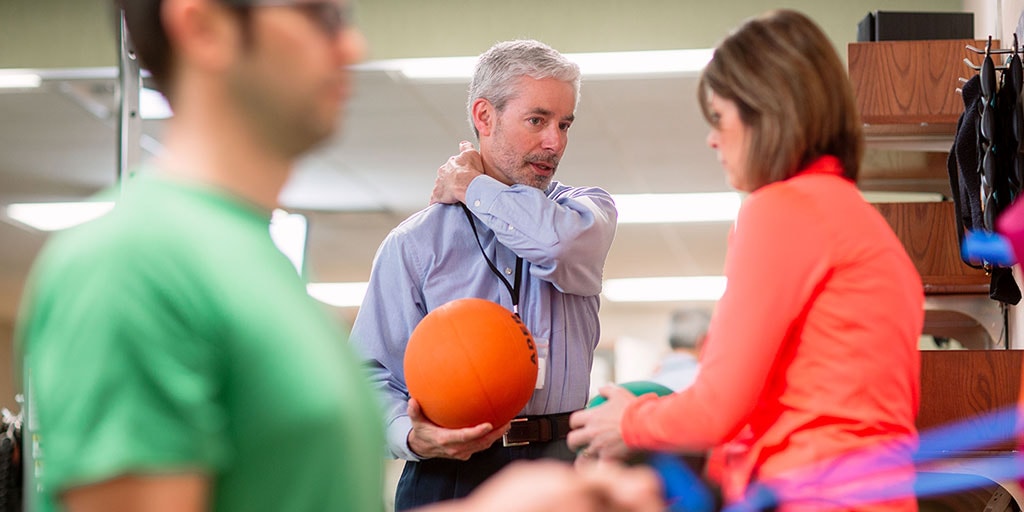
Physical Therapist
What does a physical therapist do.
Physical therapists diagnose and treat patients who have medical problems or injuries that limit their abilities to move or function in their daily lives. Patients will typically come to a physical therapist after being referred by their primary physician. Physical therapists work with people who have experienced an injury or disease that has affected their movement and range of motion.
A physical therapist will examine a patient then create a recovery plan. They often focus on treatments that reduce the need for surgery and prescriptive drugs. A physical therapist uses a combination of exercise, stretches, hands-on techniques, and equipment to restore function or relieve pain.
Scope of practice
Physical therapists work with physical therapy assistants, educators, social workers , nurses , doctors, and surgeons to treat patients of all ages, from infants to the elderly. Common tasks and duties include:
- Diagnosing patients to determine a level of function by observing them stand, walk, and perform tasks, as well as listening to their concerns
- Designing an individualized care plan based on their observations of the patient, the patient’s goals and expected outcomes, available research on the condition, and their medical expertise
- Evaluating the progress of the patient and adjusting care plans when necessary
- Developing and implementing plans to successfully discharge
Specializations
With certification, physical therapists can specialize in a particular area, including:
- Cardiovascular and pulmonary
- Clinical electrophysiology
- Orthopedics
Work environment
Physical therapists work in hospitals, private practices, home health agencies, outpatient rehabilitation centers, nursing homes, schools, and medical clinics. They are on their feet for the majority of their working day, and often need to use their bodies to work with patients – including needing to lift or move them. A typical day shift, weekday work schedule can be expected, but some work settings may require evening or weekend hours.
Becoming a physical therapist
If you’re looking for a rewarding career and don’t mind six to seven years of higher education, becoming a physical therapist might be a great career choice for you; physical therapists report having a lot of personal fulfillment from their job.
Higher education requirements
To become a physical therapist, you’ll need to complete a physical therapy program. Specifically, you’ll need to either complete a bachelor's degree and then a doctoral program in physical therapy, or you might choose a 3+3 physical therapy program that combines the degrees into a total of six years of higher education.
Once a degree is achieved, some physical therapists choose to enroll in a residency or fellowship program after graduating from their doctoral program. This will provide the physical therapist with advanced training and mentorship; it will also allow them to specialize and develop expertise in a specific area.
Certification process
Certification is not required, but may provide additional opportunities for physical therapists. In order to become board certified, you must have a doctoral degree in physical therapy, must have completed at least 2,000 hours of clinical experience, and must pass a certification exam.
Career opportunities and outlook
Physical therapists can expect a median annual salary of $ 95,620 .
According to the Bureau of Labor Statistics , employment of physical therapists in the U.S. is expected to grow much faster than average. This is due to the aging baby-boomer population who are staying active later in life and are more likely to deal with health conditions that can benefit from physical therapy. Secondly, there has been an increase in chronic conditions such as diabetes and obesity so physical therapists are needed to help these patients manage the effects of these conditions.
With additional training and experience, some physical therapists move into management roles with more responsibilities or start their own practices. Some therapists become professors while others earn specializations in areas such as pediatrics or sports medicine to increase career opportunities.
By the numbers
median annual salary
years of higher education
job growth projected from 2020-2030
Physical therapist programs at Mayo Clinic
Mayo Clinic offers several physical therapy programs to train students for a career as a physical therapist.
- Physical or Occupational Therapy Internship (Florida)
- Physical Therapy Doctoral Program (Minnesota)
- Physical Therapy Acute Care Residency (Arizona)
- Physical Therapy Geriatric Residency (Arizona)
- Physical Therapy Internship (Arizona)
- Physical Therapy Internship (Minnesota)
- Physical Therapy Neurologic Residency (Minnesota)
- Physical Therapy Orthopedic Residency (Minnesota)
- Physical Therapy Sports Residency (Minnesota)
Browse similar careers

Athletic trainer

Medical massage therapist
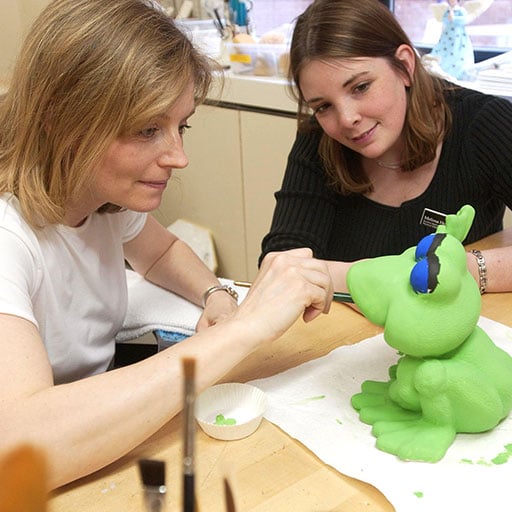
Recreational therapist
Careers in healthcare: Let us help you find your fit
How to become a physical therapist
Is becoming a physical therapist right for me.
The first step to choosing a career is to make sure you are actually willing to commit to pursuing the career. You don’t want to waste your time doing something you don’t want to do. If you’re new here, you should read about:

Still unsure if becoming a physical therapist is the right career path? Take the free CareerExplorer career test to find out if this career is right for you. Perhaps you are well-suited to become a physical therapist or another similar career!
Described by our users as being “shockingly accurate”, you might discover careers you haven’t thought of before.
How to become a Physical Therapist
To become a physical therapist, you must complete a specific educational path and obtain a license to practice in your state. Here are the steps to become a physical therapist:
- Obtain a Bachelor's Degree: While there is no specific major required to become a physical therapist, you must first obtain a bachelor's degree in any field. However, many students choose to major in a science-related field such as biology or kinesiology , as these degrees may provide a more solid foundation for future study.
- Complete a Doctor of Physical Therapy (DPT) Program: After obtaining a bachelor's degree, you must then complete a Doctor of Physical Therapy (DPT) program, which typically takes three years to complete. DPT programs include both classroom and clinical coursework in subjects such as anatomy, physiology, neuroscience, biomechanics, and patient care.
- Complete Clinical Rotations: DPT programs require students to complete clinical rotations, which provide hands-on experience working with patients under the supervision of a licensed physical therapist. Clinical rotations are typically completed during the final year of the DPT program.
- Obtain a License: After completing a DPT program, you must obtain a license to practice physical therapy in your state. Licensure requirements vary by state but typically include passing the National Physical Therapy Examination (NPTE) and completing a certain number of clinical hours.
- Optional Specialization: After obtaining licensure, physical therapists may choose to pursue additional specialization in areas such as sports therapy, neurologic therapy, pediatric therapy, or geriatric therapy. Specialization typically requires additional coursework and clinical experience.
Certifications Physical therapists can pursue a variety of certifications to demonstrate their expertise in certain areas of practice. Here are some of the most common certifications for physical therapists:
- Board-Certified Clinical Specialist: The American Board of Physical Therapy Specialties (ABPTS) offers clinical specialist certification in a variety of areas, including orthopedics, neurology, sports, and pediatrics. These certifications require additional education and clinical experience beyond what is required for licensure, and passing a specialty certification exam.
- Certified Strength and Conditioning Specialist (CSCS): Offered by the National Strength and Conditioning Association (NSCA), this certification is designed for professionals who work with athletes and active individuals to improve their physical performance.
- Certified Orthopedic Manual Therapist (COMT): This certification is offered by the International Academy of Orthopedic Medicine and is designed for therapists who specialize in manual therapy techniques to treat musculoskeletal conditions.
- Certified Hand Therapist (CHT): The Hand Therapy Certification Commission (HTCC) offers certification for therapists who specialize in treating conditions of the hand and upper extremities.
- Clinical Electrophysiology Specialist (ECS): Offered by the ABPTS, this certification is for physical therapists who specialize in the use of electrotherapy and other physical agents to treat conditions such as pain and muscle weakness.
- Geriatric Certified Specialist (GCS): This certification is offered by the ABPTS and is designed for physical therapists who specialize in treating older adults.
Online Resources There are a variety of online resources available for physical therapists that can help with continuing education, professional development, and staying up-to-date with the latest research and trends in the field. Here are some of the top online resources for physical therapists:
- American Physical Therapy Association (APTA): The APTA is the largest professional organization for physical therapists in the United States, and their website provides a wealth of resources for members, including continuing education courses, research articles, and career development tools.
- Physical Therapy Web: This website provides a variety of resources for physical therapists, including articles on clinical topics, job listings, and discussion forums for networking with other professionals.
- Physiopedia: This online platform provides an open-access repository of knowledge for physical therapy professionals, with articles, videos, and case studies on a variety of topics.
- MedBridge: MedBridge is an online education platform that provides continuing education courses for physical therapists, as well as tools for patient education and engagement.
- PTNow: PTNow is an online resource provided by the APTA that includes clinical practice guidelines, patient education materials, and other resources for evidence-based physical therapy practice.
- Rehab Essentials: Rehab Essentials is an online education platform that offers continuing education courses for physical therapists, as well as resources for exam preparation and career development.
How to Become a Physical Therapist [Ultimate Guide]
Learning how to become a physical therapist could be the first step toward embarking on this exciting career path.

Physical therapists are healthcare providers who can make a lasting difference for people recovering from injuries, surgeries, and other physical difficulties.
Editorial Listing ShortCode:
As you explore what it takes to become a physical therapist, you can decide whether physical therapist training is the right college choice for you. If it is, you’ll study the human body, the healthcare system, and the best strategies for therapeutic intervention.
How to Become a Physical Therapist
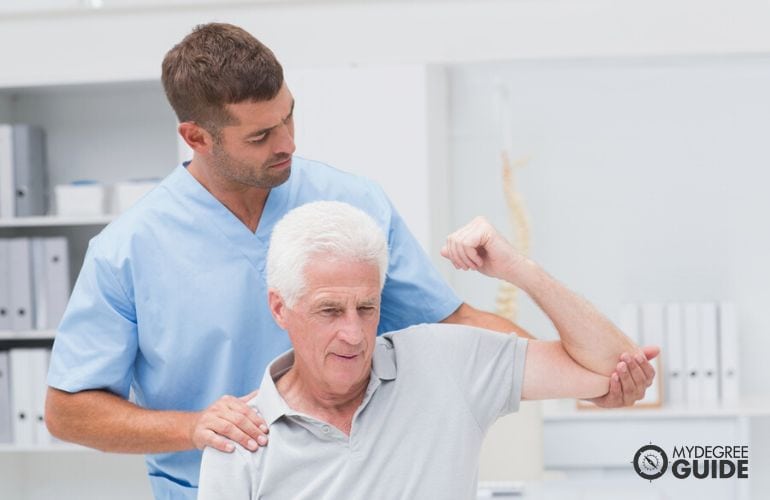
Becoming a physical therapist is a multi-step process that begins with your college education and leads to state licensure. Here are the typical steps:
- Complete a bachelor’s degree . You can choose your major since there’s not a set field of study required for physical therapist schooling. You are required to take prerequisite courses, though. A major like kinesiology or biology would provide the necessary background for PT school.
- Work as a volunteer . Schools often require applicants to have completed a set number of hours as a volunteer or an intern in a physical therapy setting.
- Enroll for your doctorate . The required degree for practicing physical therapists is a Doctor of Physical Therapy (DPT) degree. You may want to apply to multiple accredited schools and make your final enrollment decision after receiving acceptance letters. Once you begin your program, you can expect it to take about 3 years. You’ll complete courses, engage in labs, and gain hands-on clinical experience during an internship.
- Take the National Physical Therapy Examination (NPTE) . After graduation, you can sit for this professional exam. It is administered by the Federation of State Boards of Physical Therapy (FSBPT). You’re required to receive a passing score before you can begin your PT career.
- Pursue licensure . You can consult your state’s licensing board to learn what is required for obtaining a PT license in your state.
- Specialize in an area of your choice . As a licensed PT, you might want to become nationally certified in a particular subfield of physical therapy. The requirements for board certification include a residency and an exam. Specialization is optional but can be beneficial for your career.
- Keep learning . To maintain your license, you will probably earn continuing education credits so that you’ll be eligible for renewal every few years.
This is a general overview of the process of becoming a physical therapist, but your path to a PT career may look somewhat different. In particular, your state’s requirements may influence the process. You can consult your state’s licensing board to learn more about the steps you’re required to take.
5 Things You Can Do as a Physical Therapist
Studying physical therapy could help prepare you for various careers that involve helping people. You might want to work in healthcare, fitness, education, or a role that combines a few of those fields.
1. Physical Therapist
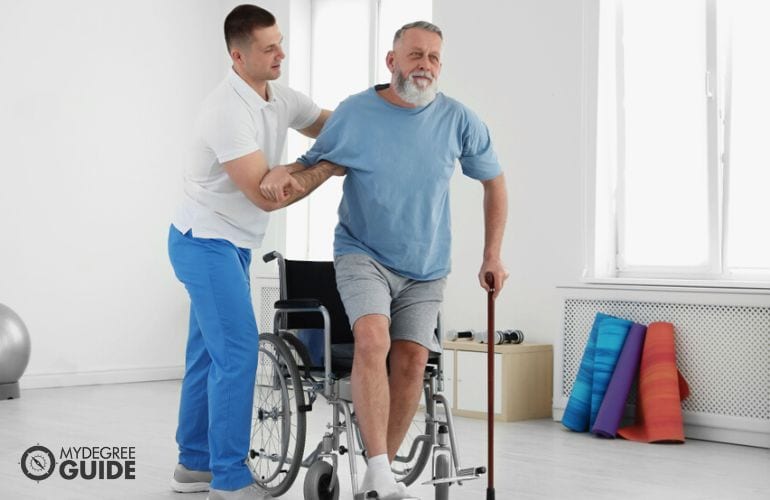
Working as a physical therapist, you could help people regain movement in parts of their body that are injured or affected by chronic conditions. Your work might also help to lessen their pain.
PTs often work in private offices, hospitals, and nursing homes. Some are self-employed.
2. Physical Therapist Assistant
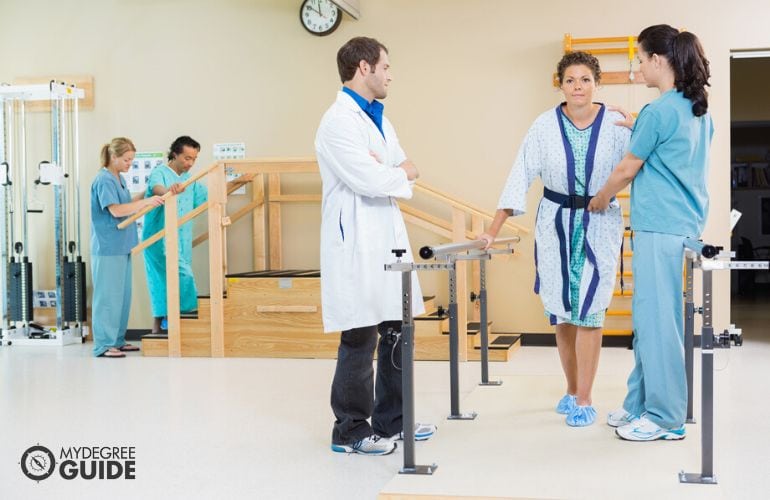
Before you are a licensed physical therapist, you could gain experience as a physical therapist assistant. As an assistant, you’d help patients with exercises and movements. You’d carry out your work under the supervision of a physical therapist.
Assistants usually need a PT associate degree and a license.
3. Physical Therapy Instructor

If you’re passionate about education, you might be able to teach students who want to work in the physical therapy field as assistants or therapists.
A DPT may qualify you only for entry-level teaching roles, such as being an adjunct instructor. With further education, you might be able to take a full-time professor position and start working toward tenured status.
4. Exercise Physiologist
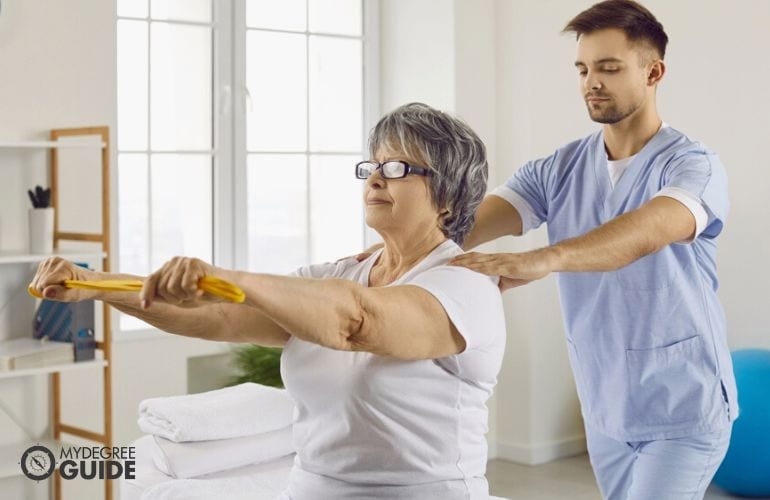
As an exercise physiologist, you could help people learn exercises to improve their physical well-being. Some people work with exercise physiologists after scares with their heart or lung health.
Others may need fitness support to help them manage their chronic health issues. Many exercise physiologists are self-employed, and others work for hospitals.
5. Recreational Therapist

You could use movement activities and other forms of recreation to help people with various conditions. Recreational therapy can be beneficial for patients with physical health problems or mental health concerns.
As a recreational therapist, you could work for a hospital, a government agency, or a skilled nursing facility.
Physical Therapy Specialty Areas
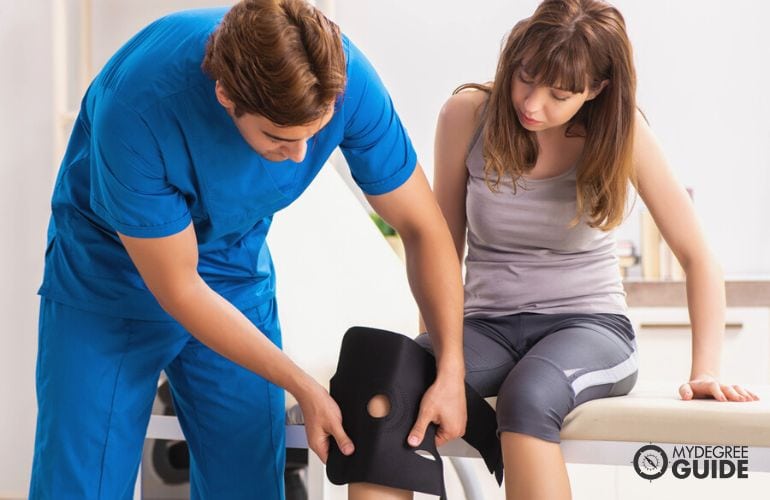
After getting your physical therapist degree, you could decide to pursue a specialty. That would demonstrate your expertise as a physical therapy professional and could lead to new job opportunities.
Here are some common PT specialty areas:
- Geriatrics . If you specialize in working with older adults, you’ll support people as they deal with conditions like arthritis, cognitive decline, and osteoporosis.
- Heart and lungs . As a pulmonary and cardiovascular specialist, you could assist patients with chronic conditions and those recovering from surgery.
- Orthopedics . As a physical therapist with a specialist in orthopedics, you could treat injuries and other issues related to the muscular, skeletal, and neurovascular systems.
- Pediatrics . In this specialty, you would focus on treating young patients, particularly those with developmental disorders and chronic conditions such as cerebral palsy or muscular dystrophy.
- Sports . You could spend your physical therapy career working with students, casual, or professional athletes to help them prevent or recover from sports-related injuries.
The requirements necessary for becoming a board-certified PT specialist include gaining thousands of clinical experience hours, completing a residency, and passing a specialty exam.
Physical Therapy Careers and Salaries
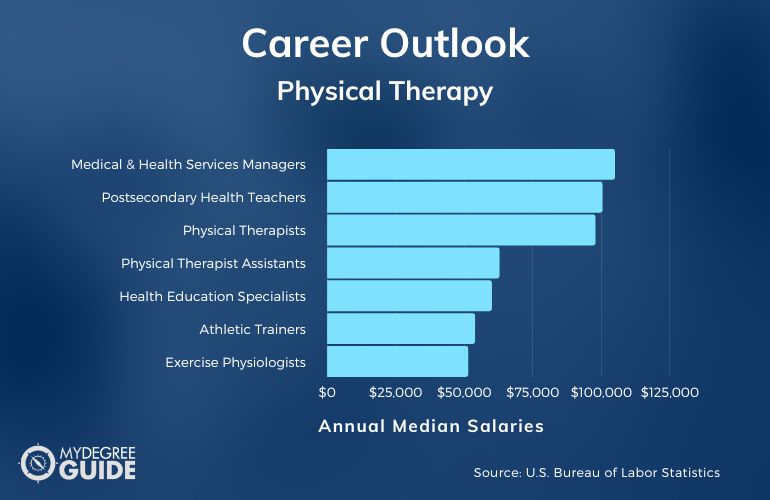
If you’re interested in helping people achieve optimal strength and range of motion, there are a variety of careers you can consider.
According to the Bureau of Labor Statistics , the median annual salary for healthcare practitioners and technical workers is $77,750.
With additional training, you might be able to transition to a role as a different sort of healthcare provider, such as an audiologist, an osteopathic physician, a chiropractor, or a speech-language pathologist.
Physical Therapy Schools Accreditation
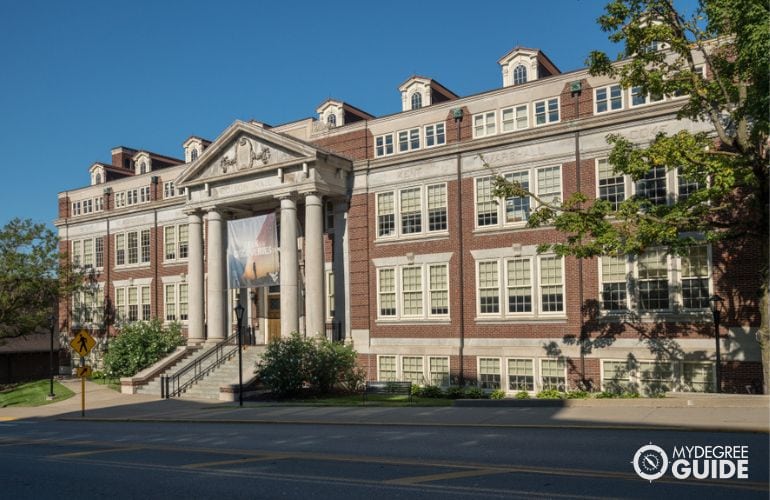
As you select schools for your various stages of physical therapy training, it’s strategic to choose ones that have regional accreditation . You can trust that those are reputable schools. Accredited institutions meet academic standards and have been approved by an official organization.
An accredited bachelor’s degree is necessary for getting into a doctoral program, and an accredited DPT is a requirement for certification and licensure. Plus, accreditation may be necessary for using financial aid or transferring credits between schools.
CAPTE Accreditation
For your PT degree, it’s beneficial to look for a college that is accredited by the Commission on Accreditation in Physical Therapy Education (CAPTE) . This programmatic accreditation affirms that doctoral programs in physical therapy meet the strict standards of this industry.
By choosing an accredited program, you can trust that your education is fully preparing you to work as a physical therapist after graduation. Plus, an accredited degree is required for anyone who applies to take the physical therapist certification exam.
Is Financial Aid Available?

Many qualifying students receive financial aid for their physical therapy schooling. Your undergraduate college may offer scholarship opportunities. Some doctoral students receive partial or full rides as well. In addition, community or national organizations might grant scholarships or fellowships to students who qualify.
Government aid is another source of funding for many students. As an undergraduate, you might receive grants, loans, or both. Loans, whether state or federal, are usually the type of aid offered to doctoral students. Filling out the Free Application for Federal Student Aid (FAFSA) is often the first step to learning about your financial aid eligibility.
What Is a Physical Therapist?

A physical therapist is a healthcare professional who helps people improve how well their body parts move or function. Therapists use exercises, massage, cold therapy, and other interventions to accomplish this goal.
Physical therapists can make a difference for people who are injured or have recently had surgery. They also help patients who have chronic conditions that affect their mobility. While physical therapists are healthcare providers, they are not medical doctors.
To become a physical therapist, a person must hold a doctorate in the field. Passing a national exam and becoming licensed by your state is required as well.
What Does a Physical Therapist Do?
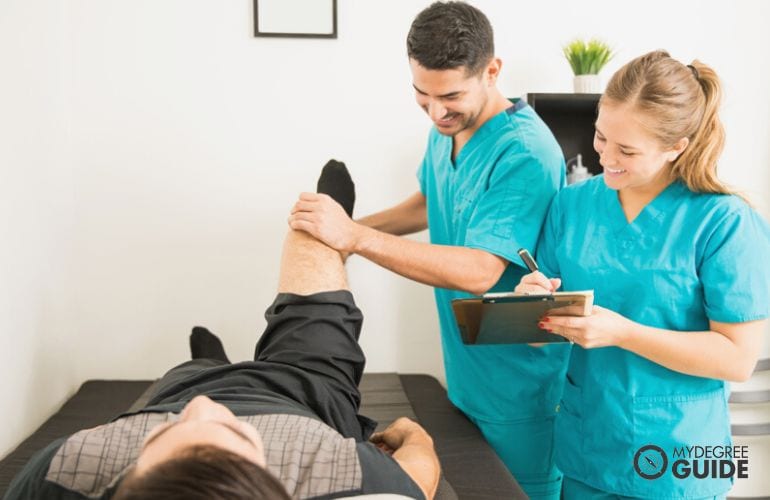
Physical therapists spend a lot of time helping patients do exercises to improve their strength, mobility, and flexibility. The therapies and interventions that PTs provide can also alleviate patients’ pain.
A physical therapy professional can also help people use various mobility devices, such as wheelchairs, prosthetics, or orthotics. Sometimes, working with a PT can help a patient graduate out of braces or other mobility supports. Physical therapy careers involve diagnosing physical problems and developing treatment plans. Documenting patients’ progress is required as well.
Where Do Physical Therapists Work?

According to the Bureau of Labor Statistics, over one-third of physical therapists work in private practice settings. Many others work in hospitals or for home healthcare services. Physical therapists can also find jobs in skilled nursing facilities and rehabilitation centers.
Some employers hire physical therapists to work with certain populations. For example, athletic facilities may hire PTs to work with their athletes. Schools may have PTs to support students with physical disabilities. Physical therapists can work for employers or be self-employed.
How Much Does a Physical Therapist Make?

According to the Bureau of Labor Statistics, most physical therapists earn between $67,910 and $128,830 each year. The highest salaries usually go to those who work for home healthcare agencies, nursing homes, and hospitals. Those who work in private practice clinics generally have lower salaries.
Physical therapist assistants can often make $43,340 to $85,230, depending on their experience level and employer. The average income for athletic trainers ranges from $39,670 to $78,000. Schools often pay the highest wages. Exercise physiologists typically make between $39,250 and $77,980. Those employed by government agencies often have significantly higher wages than those employed elsewhere.
What Are the Education Requirements for a Physical Therapist?

To become a physical therapist, you’re required to earn at least two college degrees. After becoming certified and licensed, you could choose to continue your education with a specialization.
- Bachelor’s degree . You can select any major with courses that are relevant to healthcare and physical therapy.
- Doctor of Physical Therapy (DPT) . For this advanced degree, you’ll take classes and practice your skills in clinical settings.
- Residency and board certification . As you prepare for specialty certification, you might study geriatrics, women’s health, or pediatrics. You’ll work with a mentor and learn to provide evidence-based care.
Maintaining your license may require ongoing professional development.
How Long Does It Take to Become a Physical Therapist?

You can expect to spend 6 to 8 years completing your initial physical therapy training. For most full-time students, the bachelor’s degree takes about 4 years, but online studies may speed up the process a bit. With full-time enrollment, it’s common to finish a DPT in 3 years. Part-time programs for working students may last about 4 years.
Some colleges offer a dual bachelors-doctorate program. Combining the two degrees into a joint program can be a time-saver. Most joint programs are designed to last about 6 years. Completing a residency and board certification will add time to your PT education.
What’s the Difference Between a Physical Therapist vs. Occupational Therapist?
Occupational therapy and physical therapy are two different healthcare careers that you could consider for improving movement.
Occupational therapists and physical therapists often collaborate. The above salary data is from the Bureau of Labor Statistics.
What’s the Difference Between a Physical Therapist vs. Chiropractor?
As either a physical therapist or a chiropractor, you could make a difference in how people physically feel and how well they can move.
The above salary data is from the Bureau of Labor Statistics. Neither physical therapists nor chiropractors are medical doctors.
Getting Your Physical Therapy Degree Online

Physical therapy can be a rewarding career because it provides opportunities to help people live with less pain and greater mobility.
If you want to become a physical therapist, now might be the time to start the process. After completing a related bachelor’s degree, you can then enroll for your physical therapy doctorate.
Earning your bachelor’s degree online could be a convenient way to complete that step. Online studies are flexible, and they’re often faster, too. After that, you might also be able to earn your Doctor of Physical Therapy online or through a hybrid program.
You could start your journey by looking at accredited physical therapy schools today!

Prerequisites and Degree Requirements
Your advisor will help you plan your schedule and meet all the requirements to graduate.
Through your academic and clinical courses, you’ll have the foundation you need to start your career in physical therapy.
- Apply now (PTCAS)
- Request information
How Long Does it Take to Become a Physical Therapist?

Becoming a physical therapist (PT) is a rewarding yet demanding journey that requires dedication, perseverance, and a significant investment of time and effort. While the average timeline spans seven to eight years, let's delve deeper into why it takes this long and how various factors can influence the duration.
The short answer: How long does it take to become a physical therapist?
Becoming a physical therapist typically takes around seven to eight years , including undergraduate studies and a Doctor of Physical Therapy (DPT) program. However, the journey's duration can vary based on individual circumstances, academic choices, and professional goals.
Below, we’ll dive into the steps to become a PT and what you can expect at each stage.
Undergraduate education
The first step towards becoming a physical therapist is completing a bachelor's degree, typically in a related field such as biology, kinesiology, or exercise science . This undergraduate education lays the foundation for understanding human anatomy, physiology, and other fundamental sciences crucial for the practice of physical therapy.
How long it takes: Completing a bachelor's degree usually takes around four years, although some students may take longer due to part-time enrollment, academic challenges, or pursuing additional certifications or minors.
Prerequisite courses
During their undergraduate studies, aspiring physical therapists must complete specific prerequisite courses required by DPT programs. These courses often include biology, chemistry, physics, psychology, and statistics, among others. Fulfilling these prerequisites ensures that students have a solid academic background before entering a graduate-level program.
How long it takes: Depending on the student's academic background and course load, fulfilling prerequisite courses can take one to two years.
Doctor of Physical Therapy (DPT) program
After completing their undergraduate education and fulfilling prerequisite requirements, aspiring physical therapists must enroll in a Doctor of Physical Therapy (DPT) program accredited by the Commission on Accreditation in Physical Therapy Education (CAPTE). DPT programs typically last three years and provide comprehensive education and clinical training in areas such as musculoskeletal, neurological, cardiopulmonary, and pediatric physical therapy.
How long it takes: The DPT program itself spans three years of intensive coursework, clinical rotations, and research experiences.
Clinical rotations
One of the most critical components of a DPT program is clinical education, where students gain hands-on experience working with patients under the supervision of licensed physical therapists. Clinical rotations typically occur in various settings, including hospitals, outpatient clinics, rehabilitation centers, and schools, allowing students to apply their classroom knowledge in real-world scenarios.
How long it takes: Clinical rotations are typically integrated throughout the three-year DPT program, with students spending several weeks or months at each clinical site.
Licensure and certification
Upon completing a DPT program, graduates must obtain licensure to practice as physical therapists. Licensure requirements vary by state but generally include passing the National Physical Therapy Examination (NPTE) administered by the Federation of State Boards of Physical Therapy (FSBPT).
Additionally, some physical therapists may choose to pursue specialized certifications in areas such as orthopedics, neurology, sports, or pediatrics, which require additional coursework and examinations.
How long it takes: The process of obtaining licensure and optional certifications can take several months to complete.
Ready to begin your journey as a PT?
In summary, the journey to becoming a physical therapist typically takes around seven to eight years, including undergraduate studies, a three-year Doctor of Physical Therapy (DPT) program, clinical rotations, and licensure/certification requirements.
However, this timeline can vary based on individual circumstances, such as academic choices, prior experience, and professional goals. Regardless of the duration, the commitment and dedication required to become a physical therapist are essential for providing quality care and making a positive impact on patients' lives.
Want to learn about other in-demand healthcare professions? Explore more professions with shifts offered through the CareRev App.
Craving more freedom and flexibility in your healthcare career?
Articles you may be interested in.

Nurses Week Spotlight: Celebrating Exceptional Dedication and Care

APRN vs NP: Understanding the Differences in Advanced Nursing Roles

What is an MSN Degree? Exploring a Master of Science in Nursing
Physical Therapy professor works at the forefront of interdisciplinary training
- May 13, 2024
- By: Eric Griffey
Related Links
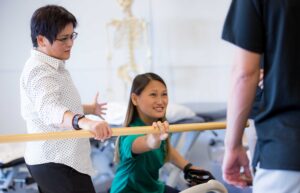
Dr. Myles Quiben was named vice chair of the newly formed Interprofessional Education and Practice, or IPEP, Special Interest Group. She is also a founding member. The newly formed group exists within the American Physical Therapy Association’s Academy of Education, a national member-run nonprofit dedicated to advancing physical therapist practice, education and research.
According to material published by the organization, the purpose of the IPEP is to serve as a resource and forum for members of the Academy of Education, who value and champion interprofessional education and collaborative practice in all facets of the physical therapy profession. IPE occurs when two or more professions learn about, from, and with each other to enable effective collaboration and improve health outcomes. IPE has been shown to support the quintuple aim of enhancing the care experience, improving population health, reducing costs, improving healthcare care wellbeing, and advancing health equity.
“If you work in a hospital or a setting working jointly with other health care professionals, you have participated in IPE and interprofessional collaborative practice,” Quiben said. “But, as a profession, we never formalized what we’re doing with IPE until the last 10 years. There’s been a stronger call among physical therapists for formalizing it.”
As of 2019, CAPTE, the Commission on Accreditation in Physical Therapy Education, incorporated IPE as a requirement for accreditation for entry-level PT programs nationwide.
The IPEP was formed after the National Interprofessional Education Consortia of the American Council of Academic Physical Therapy was dissolved. Quiben was the chair of that group of dedicated physical therapists committed to advancing IPE and IPCP.
“We needed a place to continue the work of IPE and showcase what we’re doing in academia, clinical practice, and everything else,” Quiben said. “We were fortunate to find a home in the Academy of Education in APTA.”
The group’s first official meeting was in February at the recent APTA Combined Sections Meeting in Boston. During that conference, the group decided on its goals:
- Foster networking and collaboration among physical therapists and physical therapist assistants interested in IPE and IPCP
- Engage in initiatives that support IPE and IPCP innovation in physical therapist and physical therapist assistant education and clinical practice
- Contribute to a culture of innovation, intellectual engagement, and leadership in the Academy of Education to support IPE and IPCP endeavors
- Facilitate excellence in IPE education through collaboration with external IPE organizations
- Disseminate information related to interprofessional collaborative practice to the physical therapy community in coordination with the Academy of Education
“Myles has played an invaluable role in ensuring the sustained vitality and growth of the IPE PT network, thereby fortifying its significance within our profession,” said Dr. Kimberly A. Beran-Shepler, chair of the IPEP Special Interest Group, and assistant professor of PT at Creighton University.
Quiben has pioneered IPE between professions and within PT. She serves in the university’s IPE Curriculum Committee and Seniors Assisting in Geriatrics Education, or SAGE, Committee. Working with Dr. Beverly McNeal, assistant professor at the Department of Physical Therapy, they hosted two other Texas-based colleges that train physical therapy assistants. Quiben guessed around 80 outside students were on campus in the Regional Simulation Center, in addition to the 49 first-year PT students. They plan to repeat the exercise this year.
She and other HSC faculty are also writing a chapter in a book about best practices in physical therapy education. Among the topics they’ll cover are IPE and simulation.
“The call for IPE happened many moons ago, way back in 1999 when the Institute of Medicine called for practitioners to address errors in health care,” Quiben said. “The World Health Organization and other organizations acknowledge the shortage of health care workers, the inadequacies of current health care systems in communications, quality, and patient safety; there’s something wrong with health care. One of the things we need to do is look at how we communicate better and how we work as a team in health care. These were issues in health care 20 years ago. And guess what? We’re still working on it right now. We need to strengthen the training of faculty in IPE/IPCP best practices and reinforce the competencies essential for the future healthcare professionals to succeed in an interprofessional healthcare environment: communication, teams and teamwork, roles and responsibilities, and values and ethics.”
Recent News

Inspirational students part of HSC’s Class of 2024

Association of Schools and Programs of Public Health brings inaugural community outreach event to HSC campus

Faculty highlight: Dr. Jehad Alzyoud

Personalized Health and Well-Being graduate pivots to altruistic career path

Quick links
- Alumni Relations
- Media Contact
- Accessibility Statement
- Accreditation Summary
- Bondholder Information
- Careers at HSC
- HSC Trust Line
- Mental Health Services
- Minors on Campus
- Notice of Nondiscrimination
- Privacy Notice
- Report Behavioral Misconduct
- Report Fraud, Waste or Abuse
- Report Sexual Misconduct, Intimate Partner Violence and Stalking
- Texas Veterans Portal
Connect with us
- 3500 Camp Bowie Blvd.
- Fort Worth, Texas, 76107
- (817) 735-2000
Social media

- Student Life
- Patient Care
- After-Action Review
- Continuing studies
- COVID-19 information
- Student services
- Nebraska Medicine
- Current Students
- Faculty & Staff
- Chinese (Simplified)
- Myanmar (Burmese)
- Powered by Google Translate
UNMC physical therapy earns NU teaching award
- Written by Melissa Lee, University of Nebraska System, and UNMC strategic communications
- Published May 15, 2024

Faculty and staff of the UNMC College of Allied Health Professions' physical therapy program: From left, first row is staff, Marcela Williams, Mary Wood, Megan Krenzer, Michelle Hawkins. Faculty are, second row, Tessa Wells, DPT, Betsy Becker, DPT, PhD, Dawn Venema, PhD; third row, Patricia Hageman, PhD, Nikki Sleddens, PhD; fourth row, Sara Bills, DPT, Kathleen Volkman, MS, Kellie Gossman, DPT; fifth row, Megan Frazee, DPT, Ka-Chun (Joseph) Siu, PhD, Grace Johnson, DPT, Joseph Norman, PhD (retired), Elizabeth Wellsandt, DPT, PhD; sixth row, Stacie Christensen, DPT, Mike Rosenthal, DSc, Mike Wellsandt, DPT. Not pictured, Laura Bilek, PhD, Teresa Cochran, DPT, Kyle Meyer, PhD, Kaitlyn Uwazurike, DPT.
University of Nebraska Interim President Chris Kabourek announced Tuesday that the physical therapy department at UNMC is the recipient of the 2024 University-wide Departmental Teaching Award.
The UDTA, one of the President’s Excellence Awards , is the University of Nebraska’s most prestigious honor for departmental excellence in teaching. Since 1993, the UDTA has recognized departments or units within the university system that have made unique and significant contributions to NU’s teaching efforts and demonstrated outstanding commitment to the education of students at the undergraduate, graduate or professional levels.
Honored departments are selected by a committee of faculty members from across the university. The award includes a $25,000 prize to be used as the department sees fit, for example for travel to a conference, instructional equipment or improvements to classroom space.
“Being selected for the 2024 University-wide Departmental Teaching Award underscores our team’s dedication to high-quality education,” said Betsy Becker, DPT, PhD, chair of the UNMC College of Allied Health Professions Department of Health & Rehabilitation Sciences, director of the physical therapy program and associate professor. “As a team, we navigate challenges, striving for excellence. I’m proud of our contributions and positive impact.”
Said Kabourek, “The fundamental mission of the University of Nebraska is to provide outstanding education to our students. The faculty and staff of UNMC’s physical therapy department are answering that call every day. The department has been a pioneer since its earliest days, leading the way in offering high-quality, accessible physical therapy education that meets workforce and health care needs across our state.
“We are a healthier and stronger state thanks to the physical therapy department’s commitment to excellence and innovation. I’m honored to publicly celebrate their extraordinary impact on many generations of students and on the well-being of our communities and all Nebraskans.”
Housed within UNMC’s College of Allied Health Professions, the physical therapy department offers a three-year professional curriculum leading to a Doctor of Physical Therapy degree. It is the only public program in Nebraska for the professional education of physical therapists, serving a crucial workforce need for the state. It currently is home to about 15 FTE faculty and 200 students and last year celebrated 50 years of graduates.
The quality of teaching is reflected in student outcomes: A 97% licensure exam pass rate for the Class of 2022-23 and a 99% graduation rate. More than 60% of recent graduates are employed in Nebraska, many of them in rural areas, helping address a growing demand for physical therapists as the population ages and more job opportunities are created.
The department is committed to serving the entire state, educating future physical therapists at UNMC’s Omaha campus as well as at the Health Science Education Complex on the University of Nebraska at Kearney campus, ensuring a strong workforce pipeline for Nebraska’s urban and rural communities alike. The physical therapy department also participates in the Kearney Health Opportunities Program (a partnership with UNK) and the Rural Health Opportunities Program (a partnership with the Nebraska state colleges), pathway programs that encourage students from rural areas to practice in rural Nebraska after they graduate.
Faculty have been leaders in adopting new technologies to enhance their teaching, including simulation experiences that allow students to practice in realistic, hands-on clinical scenarios. The department also supports its students outside the classroom, for example with a “buddy” program that pairs incoming students with upper-class mentors on their first day of class to ensure they have peer support throughout their course of study.
Additionally, faculty, staff and students are actively engaged in serving the community, participating in programs that provide affordable health care to Nebraskans in need, volunteering to offer companionship to Nebraskans with long-term conditions such as multiple sclerosis or spinal cord injury, and working with UNMC’s Munroe-Meyer Institute to create mobility devices for children with movement limitations.
“I would like to thank Interim President Kabourek and the selection committee for this prestigious recognition of our outstanding physical therapy program,” said Kyle Meyer, PhD, dean of the UNMC College of Allied Health Professions. “The award reflects the program’s commitment to providing an extraordinary educational experience for students, as well as a commitment to advancing the field of physical therapy for the patients and communities our faculty and graduates serve.”
UNMC Chancellor and incoming University of Nebraska President Jeffrey P. Gold, MD, congratulated Drs. Becker and Meyer on the award.
“Under the leadership of Dr. Meyer and Dr. Becker, the physical therapy program at UNMC will only continue to excel,” he said. “This honor is richly deserved, and we are proud of their work, as well as the impact of that work here in Nebraska and beyond.”
Members of the physical therapy department will be honored along with other President’s Excellence Awards recipients at the Aug. 8 Board of Regents meeting.
10 comments
What a great team! Well deserved and congratulations!
Cheering for our outstanding colleagues and friends in Physical Therapy for educational excellence. Congratulations to all!
Congratulations to the PT program and CAHP on earning this award! This is well-deserved recognition for your commitment to excellence in education.
Congratulations, team! Well deserved recognition for your incredible work.
Congratulations and well deserved.
Congratulations to all physical therapy department at UNMC, Great Team work keep it up!!
Congratulations, colleagues! A well-deserved honor.
Congrats to the CAHP’s dedicated PT staff and faculty on this well-deserved recognition!
The PT team is incredible! Well deserved.
Congratulations PT faculty and staff! What a wonderful honor to be recognized across the NU system for your work and dedication to the quality education of physical therapy students!
Leave a comment Cancel reply
Your email address will not be published. Required fields are marked *
Save my name and email in this browser for the next time I comment.
This site uses Akismet to reduce spam. Learn how your comment data is processed .

How To Become A Physical Therapist: 7 Steps

Industry Advice Healthcare
If you or your loved ones have ever recovered from a serious injury or illness, you’ve likely consulted with a physical therapist (PT) for healing and guidance. Physical therapists help people regain strength and reach their rehabilitation goals, providing much-needed support at often a difficult time in patients’ lives. In fact, observing the great work they do may have sparked your personal interest in how to become a physical therapist.
Physical therapy is a broad field that overlaps with nearly every type of healthcare practice. Whether you enjoy helping people recuperate or teaching them how to manage pain, therapeutic careers offer countless ways to make a difference in the lives of others.
Here’s an overview of what physical therapists do, how to become one, and the essential steps to becoming a physical therapist.
What Does a Physical Therapist Do?
“A physical therapist is someone who assists with the pathology of human movement,” says Dr. Christopher Cesario, Associate Clinical Professor and Director of Student Affairs for the Doctor of Physical Therapy (DPT) program at Northeastern University’s Bouvé College of Health Sciences. Patients treated by PTs are typically coping with impaired mobility or a loss of muscular strength with diverse medical needs ranging from children with developmental disorders to seniors rebuilding motor functions after a stroke. Injuries from accidents, work, and sports are also common issues.
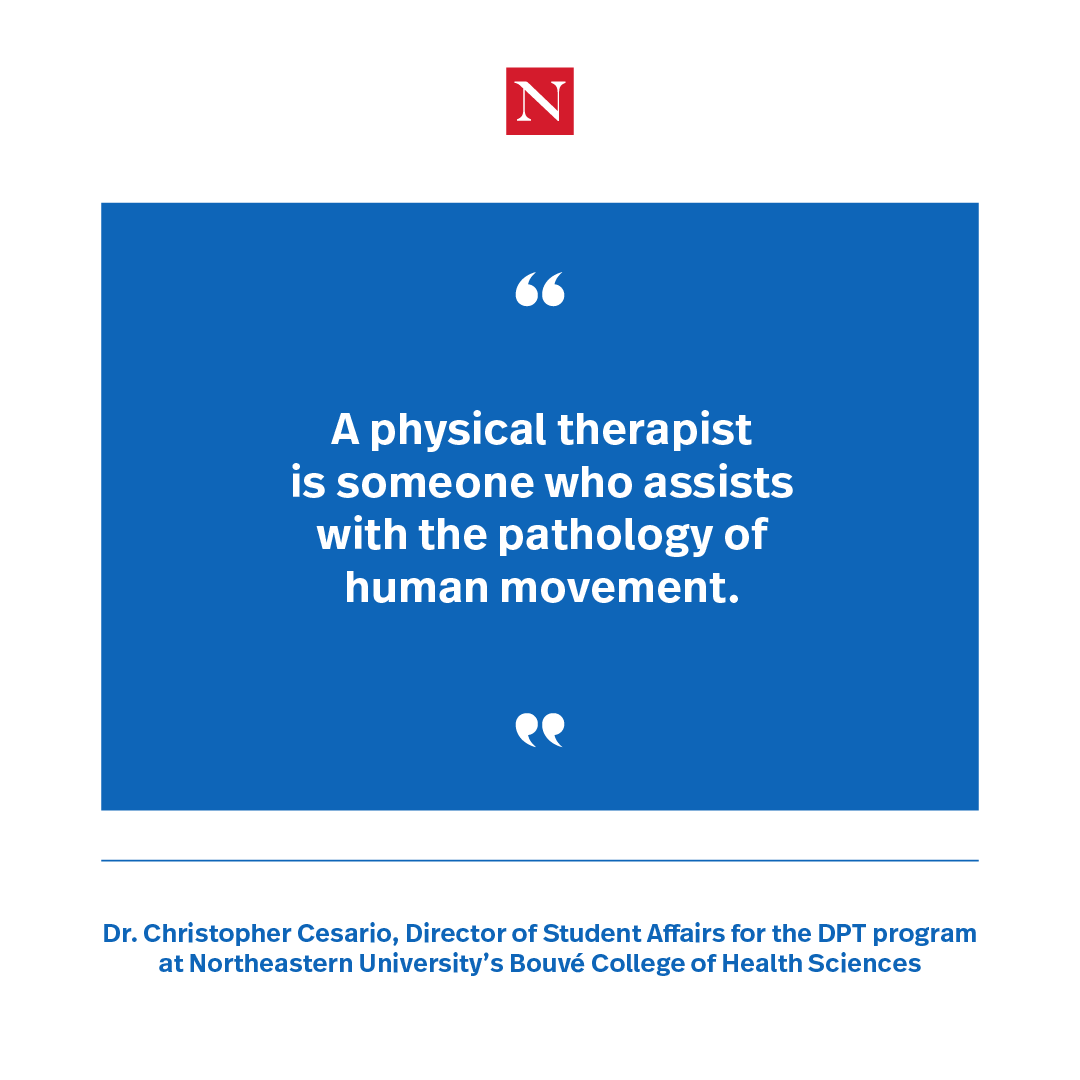
Physical therapists know how to “look at orthopedic, neurological, and cardiovascular issues and help navigate those problems,” says Cesario. Working alongside other healthcare providers, they diagnose physical impairments and create treatment plans around therapeutic exercise to help patients either recover from trauma or adapt to mobility challenges. In addition to having strong clinical experience, PTs must be compassionate and supportive of patients while using their observation and judgment skills to evaluate their needs.
How To Become a Physical Therapist
If you’re a current student or planning to go back to school, you may wonder how long it takes to become a physical therapist. Although physical therapy has a clearly outlined path to licensure, the timeline depends on your professional background, where you are in your education, and whether you can commit to full-time enrollment.
Download Our Free Guide to Physical Therapy
Everything you need to know about becoming a physical therapist
DOWNLOAD NOW
Here’s what to expect when working toward becoming a physical therapist if you have no prior background in this field.
1. Obtain a Relevant Undergraduate Degree
Physical therapist education occurs at the doctoral level, so you must earn an undergraduate degree before you can pursue this career path. While many physical therapy schools require a degree in a related field, having relevant education also increases your competitiveness in programs that don’t require it. Luckily, physical therapy encompasses many topics across the science, health, and fitness disciplines, offering various flexible options.
Acceptable majors vary by program, but some examples include:
- Kinesiology
- Health Sciences
- Exercise Science
Many of the foundational education courses provided in these degree programs can often help accelerate the process of becoming a physical therapist. This is largely because these prerequisite courses are needed in order to advance your education.
2. Determine What Type of Job You Want
By determining the type of job you want in advance, you can make better choices about your educational path and get more value out of a physical therapy program. Physical therapists work with people of all ages who have diverse health goals. As a result, prospective PTs have the opportunity to explore a range of specialties and healthcare environments before graduating.
“I think it’s worth the time to do some observation,” says Cesario. “The general public’s perception of physical therapy is that it’s all orthopedics. And when students find out that there’s physical therapy in a hospital or other settings, it’s kind of enlightening to know that there’s other options.”
With this in mind, try to consider the type of patients you want to work with, conditions you want to treat, and workplace settings you prefer. Some of the healthcare facilities that employ physical therapists are:
- Neurological
- Cardiovascular
3. Obtain a Doctor of Physical Therapy Degree
Earning a Doctor of Physical Therapy (DPT) degree is required to become a physical therapist. While any accredited DPT programs provide the knowledge and clinical experience needed to succeed in this field, it’s important to consider each program’s prerequisite courses. For example, many programs are tailored to students who already have substantial undergraduate credits in the health sciences. In addition, some schools require GRE exam scores, while others do not. As you compare your options, make sure the curriculum is in line with your personal and professional goals, and you can satisfy the admission criteria.
At the same time, keep an open mind throughout your education. Look for physical therapy programs that offer in-depth insight into different disciplines through research labs, simulated clinics, or mentorships. A diversified education, like Bouvé’s Post Baccalaureate Doctor of Physical Therapy degree program , will give you the comprehensive knowledge to evaluate complex medical histories and provide high-quality patient care in a variety of settings.
“We’ve had a trend in recent years where students come in and they’ve already self-identified that they want to be a pediatric, orthopedic, etc. therapist,” says Cesario. “Even if you’re coming into your education with the mentality that you want to do this kind of physical therapy, you still need to understand how the whole body works.”
4. Develop Relevant Skills
Focus on skill-building throughout your education since these competencies are essential for long-term career mobility. According to our analysis of job postings data, the top specialized skills for this career include:
- Rehabilitation
- Treatment planning
- Home health care
- Patient treatment
- Orthopedics
- Discharge planning
- Patient screening/evaluation
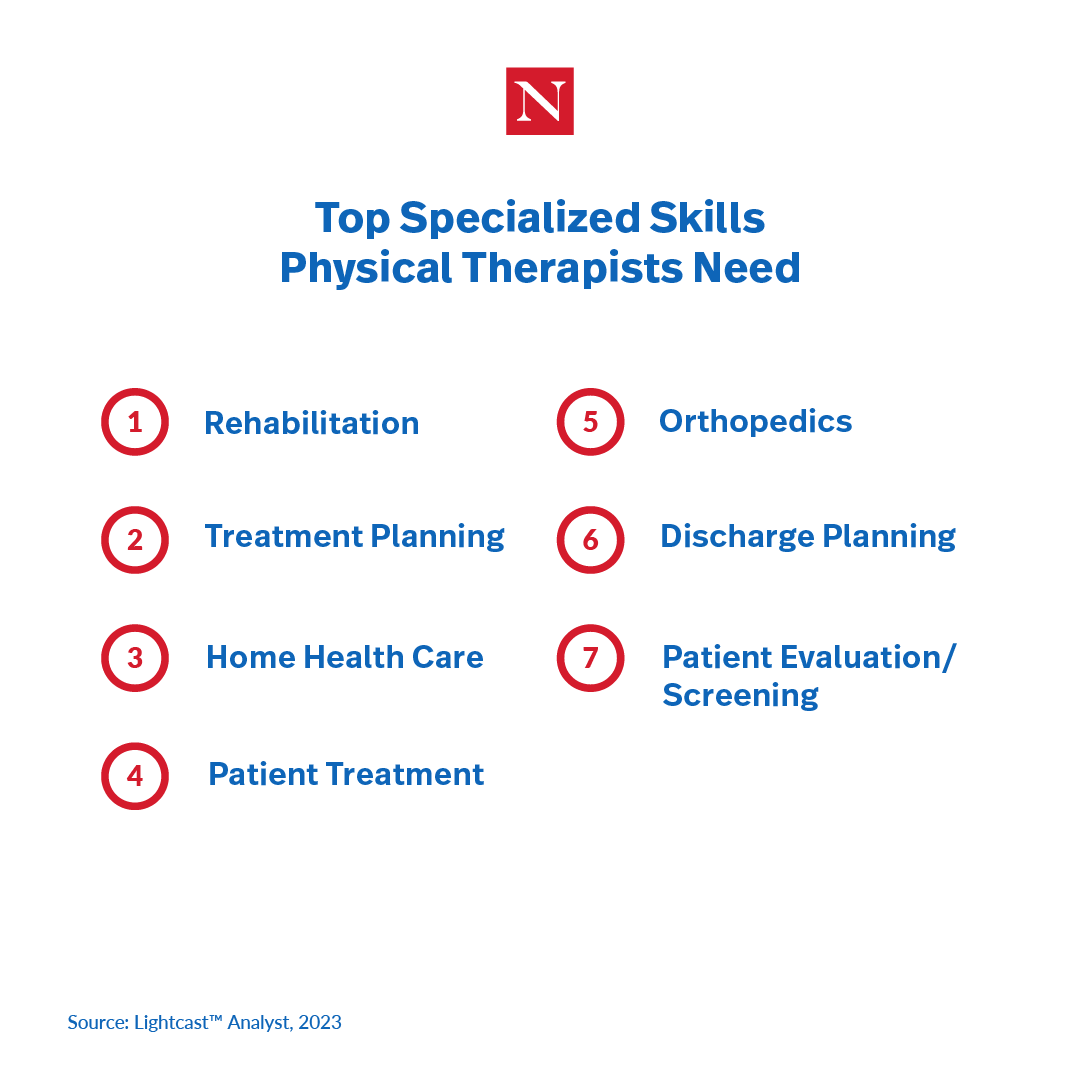
Cesario also believes patient education is another essential skill prospective PTs should develop during their education. “Patient education is something that physical therapists do well and often on a regular basis.”
In addition to technical skills, Cesario urges prospective PTs to work on their soft skills since this is inherently a “service profession.” Being able to effectively communicate, schedule, and educate patients are essential to becoming a better care provider. According to our analysis of job postings data, the top common skills required in this field include:
- Communications
- Coordinating
- Interpersonal communications
- Customer service
- Computer literacy
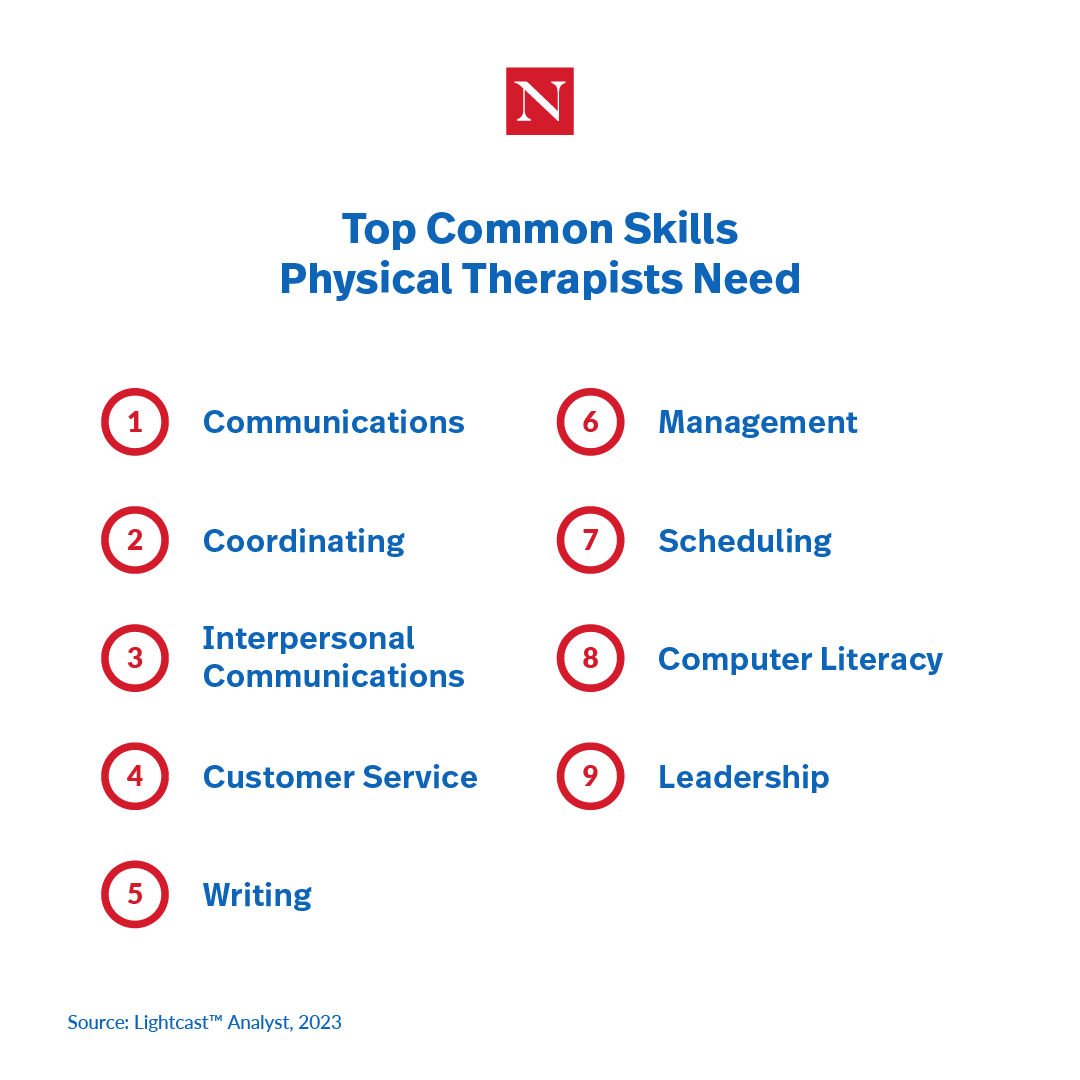
5. Obtain Additional Relevant Qualifications
It’s important to note that completing the required physical therapy education alone doesn’t allow you to immediately start practicing. So, how do you become a physical therapist after earning a DPT degree?
First, it’s essential to understand your state’s licensing requirements for physical therapists. If you plan on moving post-graduation, ensure you check these requirements in the state you hope to work in. Gaining licensure is achieved by passing the National Physical Therapy Examination (NPTE). Many institutions offer assistance throughout this process, but the level of support offered to students to prepare for the NPTE is another factor you should consider when choosing a DPT program.
In addition to these requirements, there are a number of valuable credentials you can pursue to increase your marketability in today’s job market. Here are the top qualifications physical therapists obtain, according to our analysis of job postings data.
Foundational Healthcare Certifications
Having the ability to stabilize someone experiencing a life-threatening emergency is critical for anyone who provides patient care. While these certifications aren’t specific to the field of physical therapy, it’s recommended prospective PTs obtain certification in:
- Basic Life Support (BLS)
- Basic Cardiac Life Support
- Advanced Cardiovascular Life Support (ACLS)
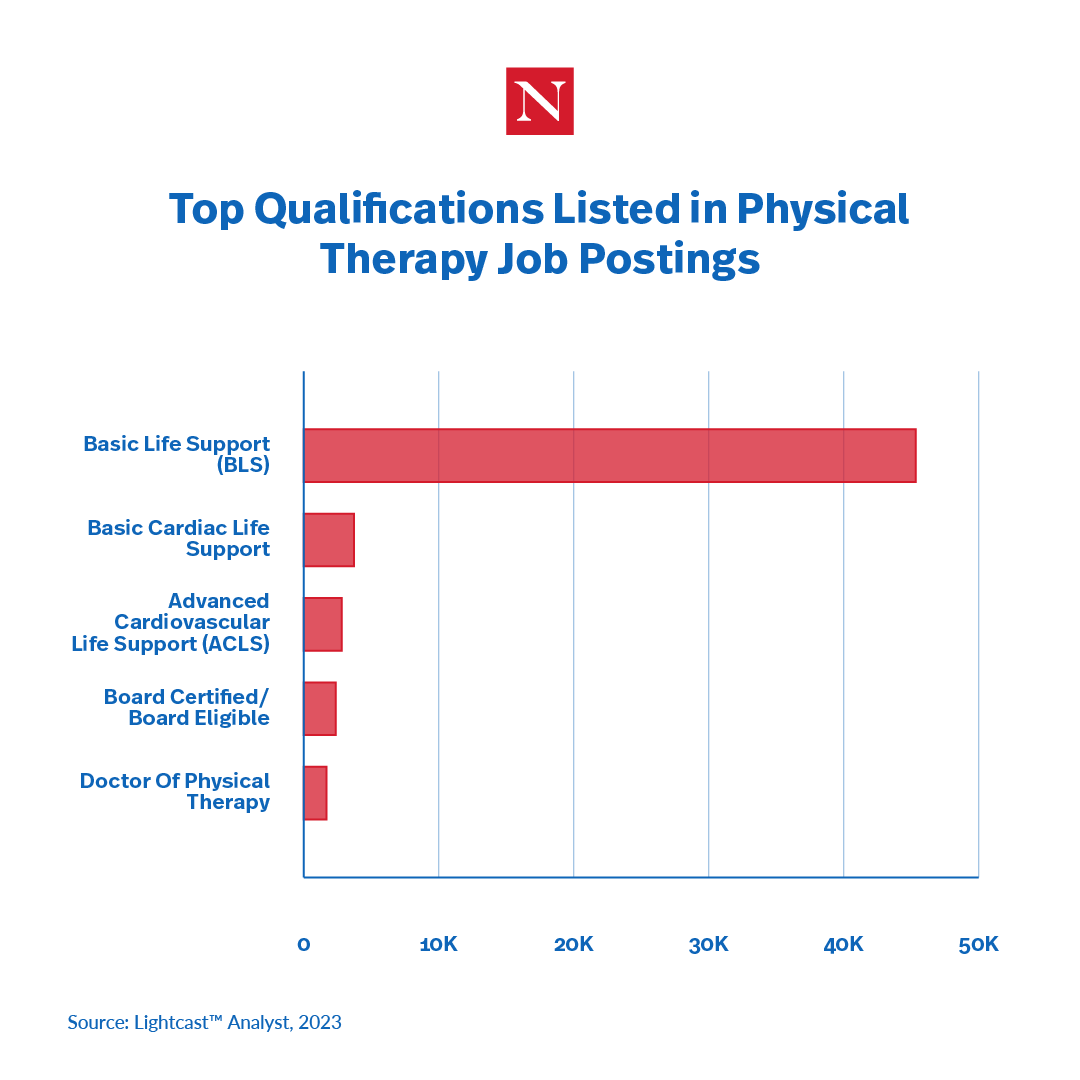
Board Certified/Board Eligible
Getting certified in a clinical specialty advances your knowledge and verifies your expertise. “Board certification is an important qualification to seek out,” says Cesario. “There are a number of opportunities for students to prepare for their boards, including self-preparation and residency programs.” Check out the American Physical Therapy Association (APTA) website to explore the ten specialty certifications they nationally recognize.
6. Build Your Professional Network
Networking before and after you become a PT can make a significant difference in your professional success. As a doctoral student, mentors and peers will be your best resources for developing your skills, researching clinical specialties, finding job opportunities, and understanding the various challenges physical therapists face on a daily basis.
Building relationships with fellow students is also helpful for sharing knowledge and evaluating healthcare from many different perspectives. As you move further into your career, your peers often continue to be a sounding board. Physical therapy involves a lot of observation and adjustment, and other PTs can offer advice and creative solutions based on their diverse experiences on the job. In addition, networking with physicians and other healthcare providers is a time-tested way to get ongoing referrals, especially if you decide to start your own private practice.
7. Gain Professional Experience
Differentiating yourself is challenging when you first start your career, so drawing on past professional experience from reputable sources is essential. Seek out opportunities that show your commitment to learning and growth, whether it’s from internships, mentorships, shadowing, research, or simulation labs.
Choosing the right school is also important because the best DPT programs provide access to critical resources for clinical experience. Physical therapy degree programs that incorporate more experiential learning opportunities in clinical practice will help you feel prepared for real-world environments and demonstrate your proficiency to prospective employers.
Start Your Career in Physical Therapy
If you’re ready to become a physical therapist, enrolling in Northeastern’s Bouvé College of Health Sciences’ Post Baccalaureate Doctor of Physical Therapy degree program is a great way to jumpstart your new career. The faculty consists of board-certified experts with years of experience in clinical specialties—most of them currently practicing therapists with a pulse on today’s industry trends.
Physical therapy students have ongoing opportunities to network and put their skills into action through internships and co-ops. Northeastern University employs an experiential learning model that centers the curriculum in real-world applications, continually encouraging students to think strategically about patient care. To learn more about what the DPT program has to offer, you can contact an admissions counselor and even connect with current students to find out if this degree is right for you.

Subscribe below to receive future content from the Graduate Programs Blog.
About shaday stewart, related articles, 4 pressing global health problems we face today, global health careers: how can i make a difference.

Compliance Specialists: Who They Are and What They Earn
Did you know.
Advanced degree holders earn a salary an average 25% higher than bachelor's degree holders. (Economic Policy Institute, 2021)
Northeastern University Graduate Programs
Explore our 200+ industry-aligned graduate degree and certificate programs.
Most Popular:
Tips for taking online classes: 8 strategies for success, public health careers: what can you do with an mph, 7 international business careers that are in high demand, edd vs. phd in education: what’s the difference, 7 must-have skills for data analysts, in-demand biotechnology careers shaping our future, the benefits of online learning: 8 advantages of online degrees, how to write a statement of purpose for graduate school, the best of our graduate blog—right to your inbox.
Stay up to date on our latest posts and university events. Plus receive relevant career tips and grad school advice.
By providing us with your email, you agree to the terms of our Privacy Policy and Terms of Service.
Keep Reading:

Should I Go To Grad School: 4 Questions to Consider

Grad School or Work? How to Balance Both

7 Networking Tips for Graduate Students

IMAGES
VIDEO
COMMENTS
Learn the steps to become a physical therapist, including education, training, licensure and specialization. Find out the salary, job outlook and requirements for this rewarding healthcare career.
Learn about the education, licensure, and career prospects of physical therapists, who are licensed doctors who help people improve their movement and function. Find out how to choose a DPT program, apply, and pursue specialization or certification.
Learn the educational requirements and steps to become a licensed physical therapist in the US. Find out about DPT programs, NPTE, state exams, and career paths in this comprehensive guide.
Learn the typical pathway to becoming a physical therapist, from earning a bachelor's degree to passing the NPTE and obtaining a license. Explore the benefits of choosing a DPT program at USAHS, a CAPTE-accredited institution that offers residential and flex formats.
Learn how to apply to a doctor of physical therapy program and what requirements you need to meet. Find out about prerequisites, GRE, interviews, criminal background checks, and more.
Learn about the education, skills, and career paths of physical therapists. Find out how much they make, where they work, and how to get patients.
Learn about the education, licensure, and career paths of physical therapists. Find out the steps, requirements, and tips for becoming a PT in this comprehensive guide.
For more information regarding state qualifications and licensure requirements, refer to the Federation of State Boards of Physical Therapy website at www.fsbpt.org. The Doctor of Physical Therapy Program at Duke University is accredited by the Commission on Accreditation in Physical Therapy Education (CAPTE), 3030 Potomac Avenue, Suite 100 ...
Learn how to become a licensed PT or PTA in the U.S. and what are the state-specific standards and procedures. Find out about the accreditation, examination, credentials evaluation, and renewal of physical therapy education programs.
An aspiring U.S. physical therapist will need to complete a Doctor of Physical Therapy degree, or DPT, which typically requires about three years of full-time study. He or she will also need to ...
Learn about the education requirements, specializations, and licensure for physical therapists. Find out how to earn a doctorate in physical therapy and pursue board certification in various areas.
Part Three Physical Therapist Salary . According to the Bureau of Labor Statistics, the median annual wage for physical therapists in May 2020 was $91,010, or $43.75 per hour.The highest 10 percent in the profession earned more than $126,780. Highest Paying States for Physical Therapists. The states that pay the highest mean annual salary are:. California - $114,230, or $54.92/hr
Learn about the education, skills, and qualifications needed to become a physical therapist. Explore the different specialties, settings, and career paths in this field.
Learn about the steps to become a physical therapist, including education, licensing and specialization. Find out the prerequisites, courses, exams and tips for choosing a PT program.
Learn how to become a physical therapist, who diagnoses and treats patients with movement or function problems. Find out about education, salary, work environment, specializations, and career opportunities at Mayo Clinic.
To become a physical therapist, you must complete a specific educational path and obtain a license to practice in your state. Here are the steps to become a physical therapist: Obtain a Bachelor's Degree: While there is no specific major required to become a physical therapist, you must first obtain a bachelor's degree in any field.
About CAPTE. The Commission on Accreditation in Physical Therapy Education (CAPTE) accredits physical therapy programs to assure quality -- both that the quality of your course work is high and that the schools produce people qualified to serve the public. In order to take the licensure exam, you must have graduated from a CAPTE-accredited program. The buttons below link to CAPTE's database of ...
Read more: How To Write a Physical Therapy Resume (With Example) Average salary for a physical therapist The national average salary for a physical therapist is currently $73,753 per year. The salary that a physical therapist can earn depends on their experience, education and qualifications, as well as the size and location of the employer.
CAPTE is a US agency that accredits entry-level education programs for physical therapists and physical therapist assistants. Learn about the accreditation process, resources, data, and how to apply to programs.
To become a physical therapist, you're required to earn at least two college degrees. After becoming certified and licensed, you could choose to continue your education with a specialization. Bachelor's degree. You can select any major with courses that are relevant to healthcare and physical therapy.
Your advisor will help you plan your schedule and meet all the requirements to graduate.. Through your academic and clinical courses, you'll have the foundation you need to start your career in physical therapy.
Undergraduate education. The first step towards becoming a physical therapist is completing a bachelor's degree, typically in a related field such as biology, kinesiology, or exercise science. This undergraduate education lays the foundation for understanding human anatomy, physiology, and other fundamental sciences crucial for the practice of ...
PTCAS The Physical Therapy Centralized Application (PTCAS) is the first step to becoming a physical therapist. WICHE & PSEP The Western Interstate Commission for Higher Education (WICHE) Professional Student Exchange Program (PSEP) enables students in 10 western states to enroll in out-of-state professional healthcare programs with reduced tuition that are available in their in-state public ...
As of 2019, CAPTE, the Commission on Accreditation in Physical Therapy Education, incorporated IPE as a requirement for accreditation for entry-level PT programs nationwide. The IPEP was formed after the National Interprofessional Education Consortia of the American Council of Academic Physical Therapy was dissolved. Quiben was the chair of ...
Housed within UNMC's College of Allied Health Professions, the physical therapy department offers a three-year professional curriculum leading to a Doctor of Physical Therapy degree. It is the only public program in Nebraska for the professional education of physical therapists, serving a crucial workforce need for the state.
Learn about the education, skills, and qualifications needed to become a physical therapist. Find out the steps to pursue a DPT degree, choose a specialty, and pass the licensing exam.
The University is also accredited on a program basis by the Commission on Accreditation in Physical Therapy Education, the Accreditation Council for Occupational Therapy Education, the Council on Academic Accreditation in Audiology and Speech-Language Pathology and the Commission on Collegiate Nursing Education.
Physical therapists support people to manage physical pain and improve movement, whereas an occupational therapist looks to improve functions associated with the pain or physical impairment. This could be through adapting equipment or teaching patients new methods of doing things. ... Offer education for a patient's family, key workers ...
APTA offers various courses and events for physical therapists and physical therapist assistants to advance their career and knowledge. Learn about the APTA Learning Center, MedBridge discount, upcoming events, and credentialed clinical instructor training.
Nine students graduated from Victoria College's physical therapist assistant program at the end of the spring 2024 semester. The graduates are Lauren Bivins of Weimar; Hannah Davis of Port ...